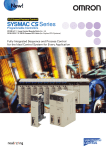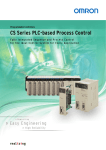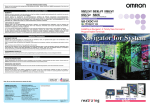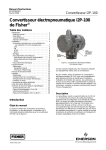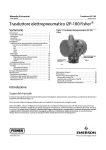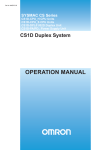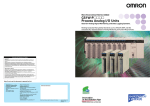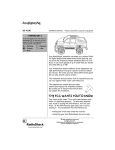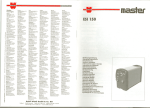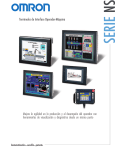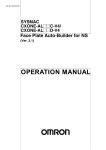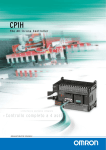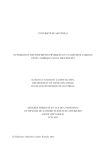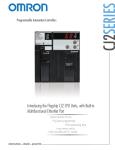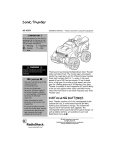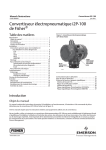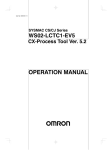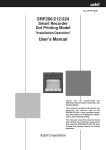Download View Datasheet
Transcript
PLC-based Process Control Series Programmable Controllers CS1W-LC Loop Control Boards/Units Ver. 3.0 (Version Upgrade) CS1D-CPU P CS1D Process CPU Units (for Duplex-CPU Systems) WS02-LCTC1-EV5 CX-Process Tool Ver. 5.0 (Version Upgrade) CS1W-P Process Analog I/O Units 8-input Models Added to Series CS1WAnalog I/O Units 16-input Models Added to Series Fully Integrated Sequence and Process Control for the Ideal Control System for Every Application Note: Do not use this document to operate the Unit. OMRON Corporation Control Devices Division H.Q. Shiokoji Horikawa, Shimogyo-ku, Kyoto, 600-8530 Japan Tel: (81)75-344-7109 Fax: (81)75-344-7149 Regional Headquarters OMRON EUROPE B.V. Wegalaan 67-69, NL-2132 JD Hoofddorp The Netherlands Tel:(31)2356-81-300/ Fax:(31)2356-81-388 OMRON ELECTRONICS LLC 1 East Commerce Drive, Schaumburg, IL 60173 U.S.A. Tel:(1)847-843-7900/Fax:(1)847-843-8568 Printed on 100% Recycled Paper Authorized Distributor: OMRON ASIA PACIFIC PTE. LTD. 83 Clemenceau Avenue, #11-01, UE Square, Singapore 239920 Tel:(65)6835-3011/Fax: (65)6835-2711 OMRON (CHINA) CO., LTD. Room 2211, Bank of China Tower, 200 Yin Cheng Zhong Road, PuDong New Area, Shanghai, 200120 China Tel: (86)21-5037-2222/Fax: (86)21-5037-2200 Note: Specifications subject to change without notice. Cat. No. P051-E1-07 Printed in Japan 0106-2M OMRON's PLC-based Process Control = Process Control General-purpose PLCs provide everything from simple loop control to advanced process control to meet customer needs. The accelerating wave of globalization calls for rebuilding systems to cope with changes in demand. And now OMRON has taken its wealth of technical know-how in factory automation and process control technology to create a PLC-based DCS functionality in a PLC process control system. Analog Units with signal conversion functions A scaleable system configuration The open nature of the PLCs is joined by integrating hardware, software, and networking to meet your needs. Increasing amounts of information, standardization, and open standards form the basis for achieving hardware and networking capabilities for process control. A wide range of software that can be easily used by design, development, and maintenance personnel makes operating and maintaining the system far easier. Operation, Monitoring, and Data Logging Touch Panels NS-series PT Application Software PLC Reporter 32 Compolet Communications Middleware FinsGateway 2003 Function block programming Sequence programming using either step ladders or sequence tables A direct link to HMI products HMI Software User Application Special HMI software CX-Process Monitor Plus Commercially available HMI software HMI software compatible with FinsGateway 2003 Ethernet or Controller Link PLC CS1 Duplex PLC CS/CJ-series * Loop Control Boards/Units CJ-series Loop-control CPU Units Process Analog I/O Units CS1D Process-control CPU Unit (for Duplex-CPU Systems) Process Analog I/O Units DeviceNet Duplex operation supported Complete maintenance functions *For details on the CJ Series, refer to the Loop-control CPU Units Catalog (R128-E1-01). 2 3 Going Beyond the Traditional Limits of PLCs with PLC-based Process Control Reducing the Total Cost of Ownership from Initial Costs through Running Costs. PLC-based Process Control Meets Customer Needs Existing System Problems Systems are large, meaning high initial costs. The over-spec nature of a distributed control system (DCS) increased costs. PLCs, however, could not provide the required process control capabilities, and signal conversion with isolators and other devices was required for I/O. It was just not possible to achieve the ideal system for a specific application. PLC-based Process Control Cut costs, Save space, Reduce labor PLCs provide the same functionality and performance as DCS while also providing the advanced features of PLCs: Open specs, easy maintenance, and cost performance. A wide range of Isolated-type Analog Units helps to save space and greatly reduces system costs. Avoid Problems and Minimize Risks with a Duplex System Increase the reliability of the facilities and devices with a Duplex PLC-based Process Control System. Duplex PLC, the basis of a continuous-operation system If an error occurs in the active CPU Unit, the standby CPU Unit takes over in an instant (using the hot standby method) so that system operation continues essentially unaffected. Other duplex variations are also possible. For example, instead of duplexing the CPU Unit, Power Supply Unit, and Controller Link Unit, a system can be constructed with a Single-CPU Unit and only a duplex Power Supply Unit or only a duplex Controller Link Unit. A duplex system means rapid recovery for errors without stopping system operation. Replace Units with power supplied or even while the system is running, including CPU Units (Duplex-CPU system), Power Supply Units, Communications Units, Basic I/O Units, and Special I/O Units. Duplex Communications Units (e.g., Controller Link Units or Ethernet Units) to increase network reliability CS1D Process Control CPU Units Duplex Power Supply Units to handle power supply problems PLC-based Process Control Application Examples In-line Blending in a Food Plant Batch Control in a Chemical Plant Personal computer HMI Software Personal computer HMI Software The manufacturer must be relied upon for everything from system construction to maintenance. Even simple changes to parameters cannot be performed in-house. And, it's nearly impossible to use generalpurpose devices and software (such as HMI devices or Windows-based software) when modifying the system. Engineering is simple when you can program with function blocks. Paste function blocks in a window just like you were creating a flow sheet, and then connect the blocks with the mouse to graphically program a wide range of process control. And with a PLC, it's easy to incorporate general-purpose HMI devices and software (such as touch panels and SCADA software). Ethernet Ethernet SYSMAC CS1 Duplex (CS1D Process-control CPU Unit) SYSMAC CS1 PLC with advanced Loop Control Board Flowrate control (blended PID control) Materials tanks Reaction control Motor Running costs are high because maintenance and modifications require specialists. Flowrate Control outputs A B Motor Motor Product tanks Motor Motor A C B Intermediate tank Drying equipment 4 5 A Revolutionary Solution to Process Control Advanced Controller Functions in a PLC For easier loop control, for advanced PLC-based analog control: The New SYSMAC CS1-based Solution Existing System Problems Excessive installation space is required. When using more than one controller for multi-loop control, the control panel is just too big. And specification changes required altering the control panel, making changes difficult. PLC-based Process Control Consolidate the functions of many controllers Programming is as simple as combining the function blocks required by the application. To increase the number of controlled loops, just add them to the program. HMI windows can also be created easily using a wide range of utility software. Adding OMRON's Storage and Processing Unit (SPU Unit), which enables high-speed, large volume, and reliable collection of logging data held in the Process Input Unit, provides a means to analyze production processes, abnormal operation, and relationships between data SYSMAC SPU and quality. Use an environment-resistant PLC Unit to collect data without a personal computer. High-speed, large-capacity data collection. Collected data is saved in CSV files. No ladder programming is required for data collection. Flexibly convert data types into different file formats. Software available to easily transfer collected data to a host computer. Memory Card CSV file Data Management CSV file Middleware Files automatically copied to a computer. Ethernet Communications must be programmed to input data to the PLC. And communications time can restrict control performance. The more controllers that are used, the more difficult maintenance becomes. CS1D Process-control CPU Unit CS1W-LCB01/05 CS-series/CS1D-S Loop Control Board Advanced controller functions are built into the CS1 PLCs. No programming is required for communications. The Loop Control Boards and Units were designed for the CS1 PLCs and require no communications programming. High-speed, flexible data links can be created with the PLC to increase control performance. Machinery (built-in devices) Programming communications with the controllers is extremely difficult. Processing facility Compact CJ-series Loop-control CPU Units ideal for equipment built-in controller applications have been added to the series, further expanding the selection to suit the application. CJ1G-CPU4 P CJ-series Loop-control CPU Unit CJ1W-TC CJ-series Temperature Control Unit Easy High-speed and highly reliable (duplex) For details on the CJ Series, refer to the Loop-control CPU Units Catalog (R128). 6 7 The Smart Products that Configure OMRON Process Control The required number of engineering steps is reduced by software that enables analog control programming by combining function blocks and easy connection to HMI devices. Loop Control Boards (LCBs) and Loop Control Units (LCUs) Packed with complete DCS functionality, the LCBs/LCUs are programmed with function blocks designed specifically for process control. By combining function blocks, a wide array of control methods, from basic PID control to cascade and feed-forward control can be easily configured. The LCB/LCU is used in combination with I/O Units to perform I/O operations. Example: Cascade Control (Heating/Cooling) Analog Input Unit Analog Output Unit PID1 Loop Control Unit/Board PV1 With Function Blocks: Isolated-type Ai4 Terminal PID1 MV1 RSP1 PV2 PID2 Split Converter Basic PID Y1 Y2 Y3 Y4 SP Y1 MV PV PVE RSP MIE MVE X1 Y1 Y2 Isolated-type Ao4 Terminal X1 X2 X3 X4 Basic PID SP Y1 MV PV PVE RSP MIE MVE Temperature Heat exchange CX-One Integrated Package Tool The CX-One is an integrated software package that includes the CX-Programmer PLC Support Software and CX-Process Loop Controller Support Software, as well as the CX-Designer PT Support Software. The CX-One provides inter-software information and settings inheritance for complete system-level support. Even advanced parameters from CPU Unit to CPU Bus Unit parameters through FA network startup can be easily set without relying on user manuals. MV2 Split conversion Temperature Y1 Y2 Y3 Y4 Steam Network Support Software: CX-Integrator CX-Process Tool PID2 Cooling water Programming Drain Process Analog I/O Units I/O tables Existing DCS's, PLCs, etc. Process I/O Units Sequence table ITEM list Block connection diagrams Engineering is simplified by a host of debugging functions that help in setting up the program. Other functions Signal converter Power supply Operation and Debugging Isolator These Analog I/O Units provide the functionality of isolators, power supplies, signal converters, and other devices. The built-in functions, such as measurement value alarms, rate-ofchange calculations, and square roots, have enabled major savings in cost and space compared with previous systems. High-resolution Models and 8-point Input Models are also available. By combining the Units, logging/monitoring systems can be constructed, or the Units can be used together with LCBs/LCUs to construct complete process control systems. Parameters can be easily displayed and set in an easy-to-understand form without special tools. Program graphically by pasting function blocks for PID control, square root calculations, or other functions in a window and then connect them with the mouse. Multiple function blocks can be grouped together to define a single user-defined function block. Function blocks can also be used in sequence tables and step ladders for sequence control programming. Parameter settings SYSMAC CS1D-series Duplex PLCs Process control system redundancy is easily achieved by mounting Process-control CPU Units to the SYSMAC CS1D system. A duplex system can greatly reduce risk in chemical plants, ship boiler systems, semiconductor utilities, or anywhere reliability is demanded. Replace Units without Stopping the System. Active Standby Problem corrected ITEM lists for individual function blocks can be monitored or settings can be changed. Parameters can be easily monitored or changed on tuning windows (up to 4 windows can be started simultaneously). Tuning data can be saved in CSV format. Individual function blocks can be added or deleted during operation. Connection, tag, and comment data can be downloaded to or uploaded from a Memory Card in a Loop Control Board (see note) or CPU Unit. Tool tuning Operation check Connection map Note: Except for CS1D Process-control CPU Units. Active CX-Process Monitor Plus Monitoring r Erro Active Standby Duplex operation resumed. This Windows-based utility is used to download function block data from Loop Controllers and to monitor the system with control windows (images of the on-site functions), trend windows, graphic windows, annunciator windows, and more. Window configurations can be easily produced by simply selecting the desired tags. Overview window 8 Trend window 9 Utility Software Progressively Easier Handling New Functions for the LCB01/05 Unit Ver. 3.0 with CX-Process Tool Ver. 5.0 Even Easier to Use Unrestricted location Engineering steps can be drastically reduced by combining a Loop Controller with an NS-series Programmable Terminal (PT). Function blocks can now be positioned anywhere on the block diagram. And, up to 64 function blocks can be placed on one diagram instead of the previous 18. This makes programs easier to read than ever before. Supported by CS1W-LCB01/05 unit Ver. 3.0 or later. Improved maintenance capabilities Backup Tags, Comments, and Connections Data Tag settings, comments, annotations, and function block connection data previously saved to Memory Cards can now also be saved in the LCB. CS1 CPU Units support simple backup functions using the Memory Card that enable backup, recovery, and comparison of all PLC data including function block data in the Loop Control Board. Created screens are easily transferred to the PT using a Memory Card or network connection. Face Plate Auto-Builder for NS Automatically Generate Control and Tuning Windows The software generates NS touch panel screen data from tag information created on the CX-Process Tool (tag names, tag comments, scaling, I/O allocations, etc.). There is no need for troublesome communications address settings on the PT or ladder programming. The generated data can be edited on the CX-Designer (NS screen creation software) as required. CX-Process Tool Ver.5.0 NS-series PT CS1 + LCB/LCU CX-Designer (NS screen creation software) Editing of created data. Creating other screens as required. Simple Backup Loop Control Board (LCB) Tag settings, comments, annotations, and function block connection data Function block data Saved to LCB or Memory Card. CX-Process Tool (function block programming software) Loop Controller programming CSV tag file output Face Plate Auto-Builder for NS CPU Unit Supported by CS1W-LCB01/05 unit Ver. 3.0 or later. Memory Card in CPU Unit Wireless debugging (calibration setting) Any desired PV can be set without using inputs from field devices to enable checking operation with only a computer and the PLC. No loads need to be connected to verify programming or check operation in advance. Supported by CS1W-LCB01/05 unit Ver. 3.0 or later. Virtual PV input using wireless debugging PV TAG001 PID 10 11 System Configuration Mounting Position System Configuration Mounting Position Loop Control Boards/Units Process Analog I/O Units CS1W-LCB01/05 Process Analog I/O Units are classified as CS-series Special I/O Units and are mounted to the CPU Rack or a CS-series Expansion Rack. The number of Units that can be mounted to a single Rack (CPU Rack or Expansion Rack) depends on the maximum supply current of the Power Supply Unit and the current consumption of other Units mounted to the Rack. Process Analog I/O Units can be mounted in any position on the Racks. The CS1W-LCB01/05 Loop Control Board is an Inner Board for CSseries CPU Units. Only one Loop Control Board can be mounted to a CS1@-CPU@@H or CS1D-CPU@@S CPU Unit. CS1-H CPU Unit CPU Rack CPU Rack PORT PORT The Loop Control Board is mounted in the Inner Board slot. I/O Unit CPU Power Unit Supply Unit CS1D-CPU6@P CS-series Expansion Rack 1 The LCB05D Duplex Loop Control Board is mounted in the Inner Board slot of the CS1D-CPU6@H and cannot be removed. CS1D CPU Rack Process-control CPU Unit I/O Unit LEFT CPU Power Supply Unit RIGHT CPU DPL SW ON INIT. SW CS-series Expansion Rack 2 PORT ON DUPLEX DUPLEX One Loop Control Board is mounted in each of the Inner Board slots (and cannot be removed). CS1W-LC001 I/O Unit The CS1W-LC001 Loop Control Unit is a CS-series CPU Bus Unit. Up to three Loop Control Units can be mounted to the CPU Rack of a CSseries or CS1D CPU Unit. Power Supply Unit Up to seven Expansion Racks can be connected. CS-series Expansion Rack 7 CPU Unit CPU Rack I/O Unit PORT Power Supply Unit Up to three Loop Control Units can be mounted in any position on the CPU Rack. PLC-based Process Control Configuration Example The process control system is configured using Loop Control Boards/Units, Process Analog I/O Units, and Analog I/O Units to control the functions of the peripheral instruments. PLC Personal computer for monitoring Personal computer used for programming and monitoring PT Compensating conductor 4 to 20 mA Sensor 12 4 to 20 mA Flow Rate Sensor Pulse signal Capacitive Flow Rate Sensor 4 to 20 mA Thermocouple Process 4 to 20 mA Loop Control Boards and Units General Specifications Loop Control Boards and Units General Specifications Item Specification Name Loop Control Boards Unit classification CS-series Inner Boards Loop Control Unit (See note 1.) Model number CS1W-LCB01: Standard Inner Board CS1W-LCB05: Special Inner Board LCB05D: CS1W-LC001 Duplex Inner Board Applicable CPU Units CS1G/H-CPU@@H CS1D-CPU@@S (See note 2.) CS1G/H-CPU@@H CS1D-CPU@@S (See note 2.) Built into the CS1D- CS-series CPU Units CPU6@P. Mounting location Inner Board slot in CPU Unit CPU Rack only Number of Boards/ Units 1 Board max. per CPU Unit 3 Units max. per CPU Unit CS-series CPU Bus Unit Data ex- I/O memory User Link Tables: ITEM data for function blocks can be allocated in any part of I/O memory (CIO, WR, HR, or DM Areas, or EM Area bank 0). change with CPU Unit All data CPU Terminal Blocks: ITEM data for function blocks can be allocated in any part of I/O memory in the CPU Unit. (CIO, WR, HR, or DM Areas, or EM Area bank 0) HMI function used to allocate function block ITEM data for Control, Op- Send/Receive All Blocks: Can be allocated in any eration, and External Controller blocks in the specified bank of the EM part of I/O memory. (CIO, WR, HR, or DM Areas, or EM Area bank 0) (Default: No data allocated.) Area in the CPU Unit. (Default: Bank 0) Setting switches None Rotary switch on front panel: Unit number (0 to F) Indicators 3 LEDs: RUN, ready, and communications port send/receive 5 LEDs: RUN operation, communications port send, communications port receive, CPU Unit error, and Unit error Front panel connections RS-232C port x 1 (The CS1D-LCB05D cannot be used to connect to the ES100X Controller.) Data backup By super capacitor: All function block data (including sequence tables By battery: All function block data (including step and step ladder instructions) ladder instructions) and error log data Battery/capacitor life 24 hours at 25°C (life shortened by use at higher temperatures) 5 years at 25°C (life shortened by use at higher temperatures) Data storage in flash memory Function block data (RAM data backup and recovery can be performed whenever necessary.) Error log data Function block data (RAM data backup and recovery can be performed whenever necessary.) Effect on CPU Unit cy- 0.8 ms max. cle time Current consumption (supplied from Power Supply Unit) 25 ms max. (See note 3.) 220 mA at 5 V DC (Increased by 150 mA when NT-AL001-E Link Adapter is used.) 0.2 ms 360 mA max. at 5 V DC (Increased by 150 mA when NT-AL001-E Link Adapter is used.) Dimensions 34.5 × 130 × 100.5 mm (WxHxD) Weight 100g max. 220 g max. Standard accessories None C200H-BAT09 Battery (mounted at time of shipment) Note: 1. The functions described here are for the Loop Control Board Ver. 2.5. 2. A Loop Control Board Unit Ver. 1.5 or later is required for use. Do not use a Loop Control Board with a unit version earlier than 1.5. 3. During duplex initialization: 2.1 s max. 13 Loop Control Boards and Units Function Specifications Function Specifications Item Specification Model numbers CS1W-LCB01 CS1W-LCB05 LCB05D (Built into the CS1D-CPU6@P.) Operation method Function block method Operation cycle Settable cycles: 0.01, 0.02, 0.05, 0.1, 0.2, 0.5, 1, or 2 s (default: 1 s) (See note 1.) Can be set for each function block. Number Analog operation of function blocks 50 blocks max. Control blocks (See note 2.) 500 blocks max. Operation blocks (See note 3.) CS1W-LC001 Settable cycles: 0.1, 0.2, 0.5, 1, or 2 s (default: 1 s) Can be set for each function block. 32 blocks max. 249 blocks max. External con- 32 blocks max. (LCB05D not included). troller blocks Sequence Sequence control tables Step ladder program blocks I/O blocks Field terminal blocks None 200 tables max. 32 conditions and 32 actions per table max. (expandable to 64 conditions and 64 actions per table) 6,400 rules total max. 20 blocks max. 2,000 commands total 100 commands max. per block Separable into a 100 steps max. 200 blocks max. 4,000 commands total 100 commands max. per block Separable into a 100 steps max. 80 blocks max User link tables 2,400 data items max. None All data HMI functions Allocated 1 EM Area bank Send/Receive All Blocks: 1 block each max. CPU terminal blocks None 16 blocks max. Node terminal blocks None 100 blocks max. System common blocks Method for creating and transferring function blocks Control PID control method methods Control combinations Alarms None 1 block max. Created and transferred using CX-Process Tool (purchased separately). PID with 2 degrees of freedom (with auto-tuning) Any of the following function blocks can be combined: Basic PID control, cascade control, feed-forward control, sample PI control, Smith dead time compensation control, PID control with differential gap, override control, program control, time-proportional control, etc. PID block internal alarms 4 PV alarms (upper upper-limit, upper limit, lower limit, lower lower-limit) and 1 deviation alarm per PID block Alarm blocks High/low alarm blocks, deviation alarm blocks Note: 1. Operation cycles of 0.01, 0.02, and 0.05 s cannot be set for the LCB05D. 2. Control blocks such as those for PID control. 3. Operation blocks for process control such as those for alarms, square roots, time/date calculations, and pulse-train computations. 14 CX-Process Tool and Monitor Software Specifications CX-Process Tool and Monitor Software Specifications Item Specifications CX-Process Tool Name CX-Process Monitor Plus CX-Process CX-Process Monitor Plus Model number WS02-LCTC1-EV5 WS02-LCMC1-E Applicable PLCs CS-series PLCs CJ-series PLCs Applicable Units CJ-series Loop-control CPU Units CS-series Loop Control Units/Boards CS1D Process-control CPU Units Compatible computers Computer IBM PC/AT or compatible CPU Minimum: Pentium 133 MHz min. Recommended: Celeron 400 MHz min. OS Microsoft Windows 2000 (Service Pack 3 or higher), NT4.0 (Service Pack 6a), 98SE, Me (see note 2), or XP Microsoft Windows 2000, NT4.0 or XP Memory Minimum: 32 Mbytes Recommended: 64 Mbytes min. Minimum: Recommended: 96 Mbytes 128 Mbytes min. Hard disk storage Minimum: 50 Mbytes free space Recommended: 100 Mbytes min. free space Minimum: Recommended: 400 Mbytes free space 500 Mbytes min. free space Monitor Minimum: XGA Recommended: SXGA 65,536 colors or more Minimum requirement: XGA (XGA or above recommended) Communications method CJ-series Loop-control CPU Units CS-series Loop Control Units/Boards CS1D Process-control CPU Units CD-ROM drive 1 drive min. Sound board --- Mouse Recommended: Microsoft mouse or compatible pointing device 1 When FinsGateway Serial Unit driver is used: Connection with CPU Unit (or Serial Communications protocol with PLC: Host Link (Peripheral Bus is not supported.) (See note 3.) • Connect the computer to the peripheral port or built-in RS-232C port of the CPU Unit, or to the RS-232C Communications port of the Serial Communications Board/Unit. Board/Unit) • Connecting cable: For connecting to peripheral port of CPU Unit: CS1W-CN@@@ (2 m or 6 m) For connecting to RS-232C port of CPU Unit: XW2Z-@@@-@ (2 m or 5 m) When CX-Server is used: CX-Server is not supported. Communications protocol with PLC: Host Link or Peripheral Bus Connecting cable: • For connecting to peripheral port of CPU Unit: CS1W-CN@@@ (2 m or 6 m) For connecting to RS-232C port of CPU Unit: XW2Z-@@@-@ (2 m or 5 m) Connection via Controller Link When FinsGateway Controller Link driver or CX-Server is used: Install the software in a computer with a Controller Link Support Board to communicate with a PLC with a Controller Link Unit mounted. Connection via Ethernet When FinsGateway ETN_UNIT driver or CX-Server is used: Install the software in a computer with an Ethernet Board to communicate with a PLC with an Ethernet Unit mounted. 15 CX-Process Tool and Monitor Software Specifications Item Specifications CX-Process Tool CX-Process Monitor Plus Offline functions Construction of user screens ITEM data settings for function blocks • Software connections for analog signals • Displaying and printing text strings (annotation) pasted on function block diagrams and ladder diagrams. • Instructions for step ladder blocks and commands for sequence table blocks • Tag settings for CX-Process Monitor Online functions • Transfer of function block data (Downloading/ Uploading for Loop Control Boards/Units.) • Starting/stopping all function blocks (LCU/LCB) • Monitoring system operation: Monitoring and controlling the System Common block (including LCB/LCU load rates) • Validating LCB/LCU operation: Checking function block connections (including starting and starting individual function blocks), validating ladder diagrams and sequence tables, and monitoring ITEMs • Tuning PID constants and other parameters (fine tuning and autotuning) • Initialization of Loop Control Unit memory (RAM) User screens • Overview screen • Control screen • Tuning screen • Trend screen • Graphic screen • Operating guide message screen System screens • Alarm history screen • System monitor screen • Operation log screen Note: 1. The CX-Process functions that can be used depend on the version. For details, refer to the operation manuals (Cat. No.: W372-E1-@ and W373-E1-@). 2. When using Windows Me, the CPU must be a Pentium 150 MHz or higher. 3. Peripheral Bus cannot be used when FinsGateway V3 is used. ■ Connections to PLC The following 4 methods can be used to connect to a PLC. Communications network Communication driver FinsGateway V3 Host Link Connection via PLC’s peripheral port or RS-232C port Peripheral Bus Controller Link Ethernet FinsGateway Version2003 (See note 1.) CX-Server V2.2 Supported (Serial Unit version is used.) Supported (See note 2.) Not supported Supported (See note 2.) Supported Connection to PLC with Controller Link Unit via Controller Link Support Board (PCI board). Supported (See note 3.) (CLK (PCI) version is used.) Supported Connection to PLC with Controller Link Unit via Controller Link Support Board (ISA board). Supported (CLK (ISA) version is used.) Supported Connection to PLC with Ethernet Unit via Ethernet Supported (Ethernet version is used.) Board. Supported Note: 1. Windows 2000 and XP are supported. (Windows 95, 98, and Me are not supported.) 2. When CX-Server is used for communications, CX-Programmer can be simultaneously connected via the same COM port. 3. The Windows 95 operating system cannot be used. 16 Function Blocks (Unit Ver. 3.0) System Common Blocks Function Blocks (Unit Ver. 3.0) System Common Blocks Type System Block Name System Common Function Makes settings common to all function blocks and outputs signals for the system. Control Blocks Type Controller Block Name Function 2-position ON/OFF (See note.) 2-position type ON/OFF controller 3-position ON/OFF (See note.) 3-position type ON/OFF controller for heating/cooling ON/OFF control Basic PID (See note.) Performs basic PID control. Advanced PID (See note.) Performs PID with two degrees of freedom control for enabling deviation/MV compensation, MV tracking, etc. Blended PID Performs PID control on the cumulative value (cumulative deviation) between the accumulated value PV and accumulated value Remote Set Point. Batch Flowrate Capture Functions to open the valve at a fixed opening until a fixed batch accumulated value is reached. Fuzzy Logic Outputs up to two analog outputs based on fuzzy logic performed on up to 8 analog inputs. Indication and Setting (See note.) Manual setter with PV indication and SP setting functions Indication and Operation (See note.) Manual setter with PV indication and MV setting functions Ratio Setting (See note.) Ratio and bias setter with PV indication and ratio setting function Indicator (See note.) PV indicator with PV alarm Note: High-speed control of function blocks is supported (the operation cycle can be set to 0.01 s, 0.02 s, or 0.05 s), except when using the LCB05D. External Controller Blocks Type External Controller Block Block Name ES100X Controller Terminal (See note.) Function Performs monitoring and setting for an ES100X Controller connected directly to the RS232C port on the Loop Control Unit. Note: LCB05D not supported. Operation Blocks Type Alarm/ Signal restrictions/Hold Block Name Function 4-Point Warning Indicator (See note 3.) Provides the alarm contact outputs for the high/high, high, low, and low/low limits of single analog signals. This function block provides the same function as the Indicator block (model 034). High/Low Alarm (See note 1.) Provides the alarm contact outputs for the high and low limits of single analog signals. Deviation Alarm (See note 1.) Provides the alarm contact outputs for the deviation of two analog signals. Rate-of-change Operation Provides the alarm contact outputs for the high and low limits of rate-of-change operation and Alarm (See note 1.) when the analog signal rate-of-change is output. High/Low Limit (See note 1.) Limits the high and low limits of single analog signals. Deviation Limit (See note 1.) Calculates the deviation between two analog signals, and limits the deviation within that range. Analog Signal Hold (See note 1.) Holds the maximum, minimum or instantaneous value of single analog signals. 17 Function Blocks (Unit Ver. 3.0) Type Arithmetic Block Name Addition or Subtraction (See note 1.) Operation Blocks Function Performs addition/subtraction with gain and bias on up to 4 analog signals. Multiplication (See note 1.) Performs multiplication with gain and bias on up to 2 analog signals. Functions Division (See note 1.) Performs division with gain and bias on up to 2 analog signals. Range Conversion (See note 1.) Easily converts up to 8 analog signals simply by inputting the 0% and 100% input values and 0% and 100% output values. Arithmetic Operation (See note 1.) Performs various math operation (trigonometric. logarithmic, etc.) on floating-point decimal values converted (to industrial units) from up to 8 analog inputs. Square Root (See note 1.) Performs square root extraction (with low-end cutout) on single analog signals. Absolute Value (See note 1.) Outputs the absolute value of single analog signals. Non-linear Gain (Dead Band) (See note 1.) Performs non-linear (3 gain values) operation on single analog signals. Analog signals can also set as a dead band (with different gap). Low-end Cutout (See note 1.) Sets output to zero close to the zero point of single analog signals. Segment Linearizer (See note 1.) Converts single analog signals to 15 segments before the signals is output. Temperature And Pressure Performs temperature and pressure correction. Correction (See note 1.) Time Function First-order Lag (See note 1.) Performs first-order lag operation on single analog signals. Rate-of-change Limit (See note 1.) Performs rate-of-change restriction on single analog signals. Moving Average (See note 1.) Performs moving average operation on single analog signals. Lead/Delay (See note 1.) Performs lead/delay operation on single analog signals. Dead Time (See note 1.) Performs dead time and first-order lag operations on single analog signals. Dead Time Compensation Used for Smith’s dead time compensation PID control Accumulator for Instantaneous Value Input Signal Selection/ Switching Accumulates analog signals, and outputs 8-digit accumulated value signals. Run Time Accumulator Accumulates the operating time, and outputs the pulse signal per specified time. Time Sequence Data Statistics (See note 1.) Records time sequence data from analog signals and calculates statistics, such as averages and standard deviations. Ramp Program Ramp program setter for combining ramps for time and hold values. Segment Program Segment program setter setting the output values with respect to time. Segment Program 2 Segment program setting with wait function for setting the output values with respect to time Rank Selector (See note 1.) Selects the rank of up to 8 analog signals. Input Selector (See note 1.) Selects the specified analog signals specified by the contact signal from up to 8 analog signals. 3-input Selector (See note Selects and outputs one of three analog input signals. 1.) ITEM Settings 18 3-output Selector (See note 1.) Outputs one analog input signal in one of three switched directions. Constant Selector (See note 1.) Selects 8 preset constants by the contact signal. Constant Generator (See note 1.) Outputs 8 independent constants. Ramped Switch Switches two analog inputs (or constants) with a ramp. Bank Selector (See note 2.) Stores a maximum of eight sets of PID parameters (SP, P, I, D, MH, ML) in advance, and switches them to basic PID, advanced PID, or blended PID parameters in response to the analog input zone or input bit. Split Converter (See note 2.) Takes an operating amount input from a basic PID or advanced PID block and converts the V characteristics or parallel characteristics into two analog outputs (e.g., heating and cooling operating amounts). Constant ITEM Setting (See note 1.) Writes the constant to the specified ITEM at the rising edge of the send command contact. Variable ITEM Setting (See note 1.) Writes the analog signal to the specified ITEM at the rising edge of the send command contact. Batch Data Collector (See note 1.) Stores each of max. 8 analog inputs to buffer by a certain timing within sequential processing. Function Blocks (Unit Ver. 3.0) Type Pulse Train Operation Block Name Accumulated Value Input Adder Sequence Control Blocks Function Adds up to four accumulated value signals. Accumulated Value Analog Multiplies analog signals by the accumulated value signals. Multiplier Others Sequence Operation Contact Type Control Target Accumulator for Accumulated Value Input Converts 4-digit accumulated value signals to 8 digits. Contact input/Accumulated Value Output Counts low-speed contact pulses, and outputs 8-digit accumulated signals. Accumulated Value Input/ Contact Output Converts 4-digit accumulated value signals to low-speed contact pulses before they are output. Analog/Pulse Width Converter (See note 1.) Changes the ON/OFF duration ratio in a constant cycle duration so that it is proportional to the analog signal. Contact Distributor Connect contact signals between function blocks in a 1:1 connection. Constant Comparator (See note 1.) Compares up to eight sets of analog signals and constants, and outputs the comparison results as contacts. Variable Comparator (See note 1.) Compares up to eight pairs of analog signals, and outputs the comparison results as contacts. Timer (See note 1.) 2-stage output type addition timer for forecast values and reached values. Can also output the present value. ON/OFF Timer (See note 1.) Timer for performing ON-OFF operation at preset ON and OFF times. Clock Pulse (See note 1.) Manipulates and monitors ON/OFF valves with open/close limit switches. Counter (See note 1.) 2-stage output type addition timer for forecast values and arrival values. Can also output the current value. Internal Switch (See note 1.) Temporary storage contact for accepting relays in the Step Ladder Program block. (Note: One internal switch is already allocated as “temporary storage” in CX-Process Tool.) Level Check (See note 1.) Checks an analog input for 8 levels and outputs a contact corresponding to the level. The level number is also output as an analog value. ON/OFF Valve Manipulator Manipulates and monitors ON/OFF valves with open/close limit switches. Motor Manipulator Manipulates and monitors motor operation. Reversible Motor Manipula- Manipulates and monitors reversible motor operation. tor Motor Opening Manipulator Inputs a target opening, and manipulates an electric positional-proportional motor. Note: 1. High-speed control of function blocks is supported (the operation cycle can be set to 0.01 s, 0.02 s, or 0.05 s), except when using the LCB05D. 2. LCB05D not supported. 3. Supported by the CS1W-LC001 only. Sequence Control Blocks Type Sequence Control Block Name Function Step Ladder Program (See note.) Performs logic sequence and step progression control. Sequence Table (See note.) Performs logic sequence and step progression control based on conditions and actions listed in tabular form. Note: High-speed control of function blocks is supported (the operation cycle can be set to 0.01 s, 0.02 s, or 0.05 s), except when using the CS1DLCB05D. 19 Function Blocks (Unit Ver. 3.0) Field Terminal Blocks Field Terminal Blocks Type Contact I/O Analog I/O Block Name Function DI 8-point Terminal (See note.) Inputs 8 contacts from 8-point Input Unit. DI 16-point Terminal (See note.) Inputs 16 contacts from 16-point Input Unit. DI 32-point Terminal (See note.) Inputs 32 contacts from 32-point Input Unit. DI 64-point Terminal (See note.) Inputs 64 contacts from 64-point Input Unit. DO 5-point Terminal (See note.) Outputs 5 contacts from 5-point Output Unit. DO 8-point Terminal (See note.) Outputs 8 contacts from 8-point Output Unit. DO12-point Terminal (See note.) Outputs 12 contacts from 12-point Output Unit. DO16-point Terminal (See note.) Outputs 16 contacts from 16-point Output Unit. DO32-point Terminal (See note.) Outputs 32 contacts from 32-point Output Unit. DO64-point Terminal (See note.) Outputs 64 contacts from 64-point Output Unit. DI 16-point/DO 16-point Terminal (See note.) Inputs and outputs 16 contacts each from 16-point Input/16-point Output Units. DI 96-point Terminal (See note.) Inputs 96 contacts from 96-contact Input Units. DO 96-point Terminal (See note.) Outputs 96 contacts from 96-contact Output Units. DI 48-point/DO 48-point Terminal (See note.) Inputs and outputs 48 contacts each from 48-point Input/48-point Output Units. AI 8-point Terminal (AD003) (See note.) Inputs 8 analog signals from the C200H-AD003. AO 8-point Terminal (DA003/4) (See note.) Inputs 8 analog signals from the C200H-DA003/DA004. AI 2-point/AO 2-point Terminal (MAD01) (See note.) Inputs and outputs 2 analog signals each from the C200H-MAD01. Inputs 4 analog signals from one of CS1W-PTS01-V1 (Isolated-type Thermocouple Input AI 4-point Terminal (PTS01-V1/02/03, PDC01, Unit), CS1W-PTS02/03 (Isolated-type Temperature-resistance Thermometer Input Unit), CS1W-PDC01 (Isolated-type Analog Input Unit) or CS1W-PTW01 (2-lead Transmitter Input PTW01) (See note.) Unit). 20 PI 4-point Terminal (PPS01) (See note.) Inputs 4 instantaneous values and accumulated values each from CS1W-PPS01 (Isolatedtype Pulse Input Unit). AO 4-point Terminal (PMV01) (See note.) Outputs 4 analog signals from CS1W-PMV01 (Isolated-type Control Output Unit). AI 8-point Terminal (PTR01/02) (See note.) Inputs 8 analog signals from CS1W-PTR01 (Power Transducer Input Unit) or CS1W-PTR02 (Analog Input Unit (100 mV)). AO 4-point Terminal (PMV02) (See note.) Outputs 4 analog signals from CS1W-PMV02 (Isolated-type Control Output Unit). Function Blocks (Unit Ver. 3.0) Type Block Name Field Terminal Blocks Function AI 4-point Terminal (PTS51) (See note.) Inputs 4 analog signals from CS1W-PTS51 or CJ1W-PTS51 (isolated-type thermocouple Input Unit). AI 4-point Terminal (PTS52) (See note.) Inputs 4 analog signals from CS1W-PTS52 or CJ1W-PTS52 (isolated-type thermocouple input Unit). AI 8-point Terminal (PTS55) (See note.) Inputs 8 analog signals from CS1W-PTS55 (isolated-type thermocouple Input Unit). AI 8-point Terminal (PTS56) (See note.) Inputs 8 analog signals from CS1W-PTS56 (isolated-type thermocouple Input Unit). AI 8-point Terminal (PDC55) (See note.) Inputs 8 analog signals from CS1W-PDC55 (Direct current Input Unit). AI 4-point/AO 4-point Terminal (MAD44) (See note.) Inputs and outputs 4 analog signals each from the CS1W-MAD44. AI 16-point Terminal (AD-161) (See note.) Inputs 16 analog signals from CS1W-AD161. AI 8-point Terminal (AD-081) (See note.) Inputs 8 analog signals from the CS1W-AD081(-V) or CJ1W-AD081(-V). AO 8-point Terminal (DA08V/C) (See note.) Outputs 8 analog signals from the CS1W-DA08V/C or CJ1W-DA08V/C. AI 4-point Terminal (AD041) (See note.) Inputs 4 analog signals from the CS1W-AD041 or CJ1W-AD041. AO 4-point Terminal (DA041) (See note.) Outputs 4 analog signals from the CS1W-DA041 or CJ1W-DA041. AI 4-point Terminal (DRT1- Inputs four analog signals from a DRT1-AD04 DeviceNet Slave Analog Input Unit. AD04) (See note.) Input Unit. AO 2-point Terminal (DRT1-DA02) (See note.) Outputs two analog signals from a DRT1-DA02 DeviceNet Slave Analog Output Unit. Note: High-speed control of function blocks is supported (the operation cycle can be set to 0.01 s, 0.02 s, or 0.05 s), except when using the LCB05D. 21 Function Blocks (Unit Ver. 3.0) Node Terminal Blocks Node Terminal Blocks Type Send to Computer Send to All Nodes Block Name Function DO to Computer Sends 128 contacts to the send-to-computer area. When CX-Process Monitor is used, the contact signals to be monitored are connected to this function block. AO to Computer Sends 16 analog values to the send-to-computer area. When CX-Process Monitor is used, the analog signals to be monitored are connected to this function block. 1-Block Send Terminal to Computer Sends a specified 1 block to the send-to-computer area. When CX-Process Monitor is used, the 1 block to be monitored are connected to this function block. 4-Block Send Terminal to Computer Sends a specified 4 block to the send-to-computer area. When CX-Process Monitor is used, the 4 block to be monitored are connected to this function block. DO Terminal to All Nodes Sends 32 contacts to nodes on the Controller Link Data Link. AO Terminal to All Nodes Sends 2 analog values to nodes on the Controller Link Data Link. DO Terminal Settings from Receives 32 contacts sent from the computer. (Can also be downloaded to the send-to-all Computer nodes area.) AO Terminal Settings from Receives 2 analog values sent from the computer. (Can also be downloaded to the send-toComputer all nodes area.) Receive from All Nodes DI Terminal from All Nodes Receives 32 contacts sent from nodes on the Controller Link Data Link. AI Terminal from All Nodes Receives 2 analog values sent from nodes on the Controller Link Data Link. CPU Unit Terminal Blocks Type CPU Unit Terminals Block Name Function DI Terminal from CPU Unit Inputs max. 128 points from any leading address in CPU Unit I/O memory (one of CIO, WR, HR, DM and EM area types). (read) DO Terminal to CPU Unit Outputs max. 128 points from any leading address in CPU Unit I/O memory (one of CIO, WR, HR, DM and EM area types). (read and write) AI Terminal from CPU Unit Inputs max. 8 words from any leading address in CPU Unit I/O memory (one of CIO, WR, HR, DM and EM area types). (read) AO Terminal to CPU Unit Outputs max. 8 words from any leading address in CPU Unit I/O memory (one of CIO, WR, HR, DM and EM area types). (read and write) SCADA Interface Blocks Type Expanded CPU Unit Terminals Block Name Function Expanded DI Terminal from Inputs any contact data in CPU Unit I/O Memory, and writes max. 64 points on another funcCPU Unit tion block. Expanded DO Terminal from CPU Unit Inputs the contact data of another function block, and writes max. 64 points on any I/O Memory in the CPU Unit. Expanded AI Terminal from Inputs any analog data in CPU Unit I/O Memory, and writes max. 64 words on another funcCPU Unit tion block. Send/ Receive All Blocks Expanded AO Terminal from CPU Unit Inputs the analog data of another function block, and writes max. 64 words on any CPU Unit I/O Memory. Receive All Blocks Reads ITEM data specified for Send/ Receive All Blocks for up to 32 Control Blocks, 249 Operation Blocks, and 32 External Controller Blocks starting from a specified address in the I/ O memory of the CPU Unit. Send All Blocks Writes ITEM data specified for Send/ Receive All Blocks for up to 32 Control Blocks, 249 Operation Blocks, and 32 External Controller Blocks starting to a specified address in the I/O memory of the CPU Unit. Note: 1. Node Terminal Blocks, CPU Unit Terminal Blocks, and SCADA Interface Blocks are supported by the CS1W-LC001 only. 2. The CS1@-LCB@@@ supports User Link Tables and an HMI instead. 22 Analog I/O Units Overview Analog I/O Units Overview Features A wide range of 25 I/O Units, including 16 Isolated-type Units, covers almost all typical applications. Also featuring high-speed (10 ms) and high-resolution (1/64,000) types, this line-up meets a diverse array of potential uses, from data logging to high-speed measurement control. • Dramatic reductions in installation cost, space, and set-up steps are attained by eliminating the need for external setters and converters. • Process value alarms and rate-of-change calculations can be executed from temperature and analog inputs. • Rate-of-change limits and high/low output limits calculated for analog output. • Peak/bottom hold and top/valley hold functions can be used for process values (CS1W-P@@1@ only). • Zero point and span can be adjusted for any specified range, and adjustment days and times can be automatically saved. The adjustment deadline and adjustment deadline expiration notice can also be set and notification given (CS1W-P@@1@ only). • Changes exceeding a set threshold can be counted, and analog input values can be integrated (CS1W-P@@1@ only). • Reduced wiring with MIL connectors (CS1W-AD161 only). XW2D-34G6 Connector-Terminal Block Conversion Unit can be used. CS1W-PTS11 CS1W-PTS12 CS1W-AD161 Overview of Process Analog I/O Units Name Model Isolated-type CS1W-PTS11 Thermocouple Input Unit (highresolution) Isolated-type CS1W-PTS12 Resistance Thermometer Input Unit (highresolution) Isolated-type DC Input Unit (high-resolution) CS1W-PDC11 CS1W-PTS51 CS1W-PTS55 Isolated-type Thermocouple Input Unit (economical type) CS1W-PTS52 CS1W-PTS56 Isolated-type Resistance Thermometer Input Unit (economical type) CS1W-PDC55 Isolated-type DC Input Unit (economical type) Isolated-type CS1W-PTS01-V1 Thermocouple Input Unit Number Field I/O I/O type Main specifications Main functions of I/O isolation (See note.) 4 inputs All inputs B, E, J, K, L, N, R, Standard accuracy: ±0.05% of F.S. Output scaling (±32,000) are isolated. S, T, U, WRe5-26, Temperature coefficient: ±0.01%/°C Process value alarms (HH, H, L, LL) Resolution: 1/64,000 PLII, ±100 mV Rate-of-change calculation and alarm InConversion period: 20 ms/4 pts, put disconnection alarm 10 ms/2 pts Top/bottom/valley hold Zero/span adjustment for any specified rang Standard accuracy: ±0.05% of F.S. or Output scaling (±32,000) 4 inputs All inputs Pt100 Ω (JIS, Process value alarms (HH, H, L, LL) are isolated. IEC), JPt100 Ω, ±0.1, whichever is larger Pt50 Ω, Ni100 Ω Temperature coefficient: ±0.009%/°C Rate-of-change calculation and alarm InResolution: 1/64,000 put disconnection alarm Conversion period: 20 ms/4 points, Top/bottom/valley hold 10 ms/2 pts Zero/span adjustment for any specified range 4 inputs All inputs 4 to 20 mA, 0 to Standard accuracy: ±0.05% of F.S. Output scaling (±32,000) are isolated. 20 mA, 0 to 10 V, Temperature coefficient: ±0.008%/°C Process value alarms (HH, H, L, LL) ±10 V, 0 to 5 V, ±5 Resolution: 1/64,000 Rate-of-change calculation and alarm InConversion period: 20 ms/4 pts, V, 1 to 5 V, put disconnection alarm 10 ms/2 pts 0 to 1.25 V, Top/bottom/valley hold ±1.25 V Zero/span adjustment for any specified range Process value alarms (H, L) 4 inputs All inputs R, S, K, J, T, L, B Centigrade Selected Total accuracy: ±0.3% of PV or ±1°C Input disconnection detection 8 inputs are isolated. whichever is larger, ±1 digit max. Conversion period: 250 ms/Unit 4 inputs All inputs JPt100, Pt100 8 inputs are isolated. (JIS IEC) Centigrade Selected Total accuracy: ±0.3% of PV or ±0.8°C, whichever larger, ±1 digit max. Conversion period: 250 ms/Unit Process value alarms (H, L) Input disconnection detection 8 inputs All inputs 4 to 20 mA, 0 to Standard accuracy: ±0.3% of F.S. Process value alarms (H, L) are isolated. 10 V, Input disconnection alarm Resolution: 1/16,000 0 to 5 V, 1 to 5 V Conversion period: 250 ms/8 inputs 4 inputs All inputs B, E, J, K, N, R, S, are isolated. T Variable range: ±80 mV DC Standard accuracy: ±0.1% Temp. coefficient: ±0.015%/°C Resolution: 1/4,096 Conversion cycle: 150 ms/4 pts Variable range setting Scaling (±32,000) Process value alarms (HH, H, L, LL) Rate-of-change calculation and alarm Input disconnection detection 23 Analog I/O Units Name Isolated-type Resistance Thermometer Input Unit Model CS1W-PTS02 CS1W-PTS03 Isolated-type Resistance Thermometer Input Unit (Ni508.4 Ω) Isolated-type 2- CS1W-PTW01 Wire Transmitter Input Unit Isolated-type Analog Input Unit CS1W-PDC01 Isolated-type CS1W-PPS01 Pulse Input Unit Isolated-type CS1W-PMV01 Analog Output Unit CS1W-PMV02 Power TransCS1W-PTR01 ducer Input Unit Analog Input Unit (100 mV) CS1W-PTR02 Overview of Process Analog I/O Units Number Field I/O I/O type of I/O isolation 4 inputs All inputs Pt100 are isolated. (JIS, IEC), JPt100 Main specifications Main functions (See note.) Standard accuracy: ±0.1% or Variable range setting ±0.1°C, whichever is larger Output scaling (±32,000) Temperature coefficient: ±0.015%/°C Process value alarms (HH, H, L, LL) Rate-of-change calculation and alarm InResolution: 1/4,096 Conversion period: 100 ms/4 pts put disconnection alarm 4 inputs All inputs Ni508.4 Ω are isolated. Standard accuracy: ±0.2% or ±0.2°C, whichever is larger Temperature coefficient: ±0.015%/°C Resolution: 1/4,096 Conversion period: 100 ms/4 pts 4 inputs All inputs 4 to 20 mA, are isolated. 1 to 5 V Standard accuracy: ±0.2% Temp. coefficient: ±0.015%/°C Resolution: 1/4,096 Conversion period: 100 ms/4 pts 4 inputs All inputs –10 to 10 V, 0 to are isolated. 10 V, –5 to 5 V, 0 to 5 V, 1 to 5 V, ±10 V DC variable range, 4 to 20 mA, 0 to 20 mA 4 inputs All inputs Max. counting are isolated. speed: 20 k pulses/s (voltage input or no-voltage semiconductor input) 20 pulses/s (contact input) 4 outputs All outputs 4 to 20 mA, are isolated. 1 to 5 V Standard accuracy: ±0.1% Temp. coefficient: ±0.015%/°C Resolution: 1/4,096 Conversion cycle: 100 ms/4 pts Variable range setting Output scaling (±32,000) Process value alarms (HH, H, L, LL) Rate-of-change calculation and alarm Input disconnection detection Built-in power supply for 2-wire transmitter Output scaling (±32,000) Process value alarms (HH, H, L, LL) Rate-of-change calculation and alarm Square root Input error detection Process value alarms (HH, H, L, LL) Output scaling (±32,000) Square root Rate-of-change calculation and alarm Input error detection --- Built-in sensor power supply Contact bounce filter Unit pulse conversion Accumulated value output Instantaneous value output and 4 instantaneous value alarms Standard accuracy: ±0.1% (4 to 20 mA) Standard accuracy: ±0.2% (1 to 5 V) Temperature coefficient: ±0.015%/°C 4,000 (outputs) Conversion period: 100 ms/4 pts Output disconnection alarm Control output answer input Output rate-of-change limit Output high/low limits Standard accuracy: ±0.1% 4 outputs All outputs 0 to 10 V, are isolated. ±10 V, 0 to 5 V, ±5 Temp. coefficient: ±0.015%/°C V, 0 to 1 V, ±1 V Resolution (full scale): ±10 V, ±1 V: 1/16,000 0 to 10 V, 0 to 1 V, and ±5 V: 1/8,000 0 to 5 V: 1/4,000 Conversion period: 40 ms/4 pts Standard accuracy: ±0.2% 8 inputs Inputs and ±1 mA, 0 to 1 mA Temp. coefficient: ±0.015%/°C PLC sigResolution: 1/4,096 nals are isoConversion cycle: 200 ms/8 pts lated. 8 inputs Inputs and ±100 mV, Standard accuracy: ±0.2% PLC sig0 to 100 mV Temp. coefficient: ±0.015%/°C nals are isoResolution: 1/4,096 lated. Conversion period: 200 ms/8 pts Output rate-of-change limit Output high/low limits Output scaling (±32,000) Anti-overshooting at motor startup Process value alarms (H, L) Output scaling (±32,000) Process value alarms (H, L) Output scaling (±32,000) Note: Varies depending on usage conditions. Refer to the Analog I/O Units User’s Manual (W368) for details. 24 Analog I/O Units Overview of Analog I/O Units Overview of Analog I/O Units Name Analog Input Unit Model CS1W-AD041-V1 CS1W-AD081-V1 Number of I/ Field I/O isolation I/O signal ranges O 4 inputs Isolated between 1 to 5 V, 0 to 5 V, 0 to 10 V, –10 to 10 V, inputs and PLC 4 to 20 mA signals. No isolation between inputs. 8 inputs CS1W-AD161 (See 16 inputs note 2.) Isolated between inputs and PLC signals. No isolation between inputs. 1 to 5 V, 0 to 5 V, 0 to 10 V, –10 to 10 V, 4 to 20 mA Isolated between inputs and PLC signals. No isolation between inputs. 1 to 5 V, 0 to 5 V, 0 to 10 V, –10 to 10 V, 4 to 20 mA Overall accuracy Voltage input: ±0.2% of F.S.: current input ±0.4% of F.S. (23 ± 2°C) Voltage input: ±0.4% of F.S.: current input ±0.6% of F.S. (0 to 55°C) Resolution: 1/8,000 (See note 1.) Conversion speed: 250 µs/point max. (See note 1.) (Can be used with a resolution of 1/4,000 and conversion speed of 1 ms.) Voltage input: ±0.2% of F.S.: current input ±0.4% of F.S. (23 ± 2°C) Voltage input: ±0.4% of F.S.: current input ±0.6% of F.S. (0 to 55°C) Resolution: 1/8,000 (See note 1.) Conversion speed: 250 µs/point max. (See note 1.) (Can be used with a resolution of 1/4,000 and conversion speed of 1 ms.) Voltage input: ±0.2% of F.S.: current input ±0.2% of F.S. (23 ± 2°C) Voltage input: ±0.4% of F.S.: current input ±0.4% of F.S. (0 to 55°C) Resolution: 1/8,000 (See note 1.) Conversion speed: 250 µs/point max. (See note 1.) (Can be used with a resolution of 1/4,000 and conversion speed of 1 ms.) Voltage output: ±0.3% of F.S.: current output ±0.5% of F.S. (23 ± 2°C) Voltage output: ±0.5% of F.S.: current output ±0.8% of F.S. (0 to 55°C) Resolution: 1/4,000 Conversion speed: 1 ms/point max. ±0.3% of F.S. (23 ± 2°C) ±0.5% of F.S. (0 to 55°C) Resolution: 1/4,000 Conversion speed: 1 ms/point max. Analog Out- CS1W-DA041 put Unit 4 outputs Isolated between inputs and PLC signals. No isolation between inputs. 1 to 5 V, 0 to 5 V, 0 to 10 V, –10 to 10 V, 4 to 20 mA CS1W-DA08V 8 outputs Isolated between inputs and PLC signals. No isolation between inputs. 1 to 5 V, 0 to 5 V, 0 to 10 V, –10 to 10 V CS1W-DA08C 8 outputs Isolated between inputs and PLC signals. No isolation between inputs. 4 to 20 mA ±0.5% of F.S. (23 ± 2°C) ±0.8% of F.S. (0 to 55°C) Resolution: 1/4,000 Conversion speed: 1 ms/point max. Analog I/O CS1W-MAD44 Unit 4 inputs 4 outputs Isolated between inputs and PLC signals. No isolation between inputs. Input: 1 to 5 V, 0 to 5 V, 0 to 10 V, –10 to 10 V, 4 to 20 mA Output: 1 to 5 V, 0 to 5 V, 0 to 10 V, –10 to 10 V Voltage input: ±0.2% of F.S.: current input ±0.4% of F.S. (23 ± 2°C) Voltage input: ±0.4% of F.S.: current input ±0.6% of F.S. (0 to 55°C) Output: ±0.3% of F.S. (23 ± 2°C) Output: ±0.5% of F.S. (0 to 55°C) I/O resolution: 1/4,000 Conversion speed: 1 ms/point max. Note: 1. The resolution and conversion speed can be switched with a DM setting. If it isn’t necessary to change the setting, the Unit can be used with the earlier model’s mode (resolution of 1/4,000 and conversion speed of 1 ms) just like the conventional model. 2. Use the OMRON XW2D-34G6 Connector-Terminal Block Conversion Unit and XW2Z-200C Connecting Cable to wire inputs. 25 Analog I/O Units Common Specifications for Process and Standard Analog I/O Units Common Specifications for Process and Standard Analog I/O Units Item Specifications Unit classification CS-series Special I/O Unit Dimensions 35 × 130 × 126 mm (W × H × D) Weight 450 g max. External connection termi- CS1W-PTS55/56, PDC55: 24-point detachable terminal block (lever type) nals CS1W-AD161: MIL connectors (34-pin × 2) Other models: 21-point detachable terminal block (M3 screws, with tightening torque of 0.5 N⋅m) Unit number switch 00 to 95 Self-diagnostic function Results shown by LED indicators. Mounting position CS-series CPU Rack or CS-series Expansion Rack Internal current consump- Confirm that the total current consumption of all the Units (including the CPU Unit) mounted to a single CPU Rack or Expansion Rack does tion not exceed the maximum power supplied by the Power Supply Unit. Name Model Current consumption (power) 5V Isolated-type Thermocouple Input Unit 26 V CS1W-PTS01-V1 0.15 A (0.75 W) 0.15 A (3.9 W) CS1W-PTS11 0.12 A (0.6 W) 0.08 A (2.08 W) CS1W-PTS51 0.25 A (1.25 W) Unused. CS1W-PTS55 0.18 A (0.9 W) 0.06 A (1.56 W) Isolated-type Resistance Thermometer Input Unit (Pt100, JPt100) CS1W-PTS02 0.15 A (0.75 W) 0.15 A (3.9 W) Isolated-type Resistance Thermometer Input Unit t (Ni508.4 Ω) CS1W-PTS03 0.15 A (0.75 W) 0.15 A (3.9 W) Isolated-type Resistance Thermometer Input Unit (Pt100, JPt100, Ni508.4 Ω) CS1W-PTS12 0.12 A (0.6 W) 0.07 A (1.82 W) Isolated-type Resistance Thermometer Input Unit (Pt100, JPt100) CS1W-PTS52 0.25 A (1.25 W) Unused. CS1W-PTS56 0.18 A (0.9 W) 0.06 A (1.56 W) Isolated-type 2-Wire Transmitter Input Unit CS1W-PTW01 0.15 A (0.75 W) 0.16 A (4.2 W) Isolated-type DC Input Unit CS1W-PDC01 0.15 A (0.75 W) 0.15 A (3.9 W) CS1W-PDC11 0.12 A (0.6 W) 0.12 A (3.12 W) 0.06 A (1.56 W) CS1W-PDC55 0.18 A (0.9 W) Power Transducer Input Unit CS1W-PTR01 0.15 A (0.75 W) 0.08 A (2.1 W) Analog Input Unit (100 mV) CS1W-PTR02 0.15 A (0.75 W) 0.08 A (2.1 W) Isolated-type Pulse Input Unit CS1W-PPS01 0.20 A (1.0 W) 0.16 A (4.2 W) Isolated-type Analog Output Units CS1W-PMV01 0.15 A (0.75 W) 0.16 A (4.2 W) CS1W-PMV02 0.12 A (0.6 W) 0.12 A (3.2 W) CS1W-AD041-V1 0.12 A (0.6 W) 0.09 A (2.34 W) Analog Input Units CS1W-AD081-V1 Analog Output Units CS1W-AD161 0.15 A (0.75 W) 0.06 A (1.56 W) CS1W-DA041 0.13 A (0.65 W) 0.18 A (4.68 W) 0.2 A (1.0 W) 0.2 A (5.2 W) CS1W-DA08V CS1W-DA08C Analog I/O Unit CS1W-MAD44 0.25 A (6.5 W) (Reference) Maximum current and total power supplied Power Supply Unit Maximum current supplied (power) 5V C200HW-PA204 4.6 A (23 W) Maximum total power 26 V 0.6 A (15.6 W) 24 V None C200HW-PA204S 0.8 A (19.2 W) C200HW-PA204R None 30 W C200HW-PD024 C200HW-PD025 5.3 A (26.5 W) 1.3 A (33. 8 W) 40 W C200HW-PA209R 9 A (45 W) 1.3 A (33.8 W) 45 W CS1D-PA207R 7 A (35 W) 1.3 A (33.8 W) 35 W CS1D-PD024 4.3 A (21.5 W) 0.56 A (14.6 W) 28 W CS1D-PD025 5.3 A (26.5 W) 1.3 A (33.8 W) 40 W Ambient operating temper- 0 to 55°C ature Note: Process Analog I/O Units can be used even if a Loop Control Board or Loop Control Unit is not used. 26 Utility Software Touch Panel Software Utility Software Touch Panel Software ■ Face Plate Auto-Builder for NS Simply specify the CSV tag file created using the CX-Process Tool to automatically create a project constructed with a Face Plate for Loop-control CPU Units for use with OMRON's NS-series Programmable Terminals. Function Overview • Create windows for monitoring and tuning PID and other function blocks for up to 100 loops (NS System version 4 or higher). • NS project files for monitoring multiple Loop-control CPU Units from a single NS-series PT can be generated from CX-Process projects for up to 32 multiple nodes. • When a Segment Program 2 function block is used for program operation, the Detailed Setting Windows (Time Interval vs. Output Value Setting Window, Wait Interval Setting Window) used for the parameter settings are also automatically generated. Basic Specifications Item Specifications Name Face Plate Auto-Builder for NS Model number WS02-NSFC1-EV2 Applicable PLC products CJ-series Loop-control CPU Units CS-series Loop Control Boards (unit version 1.0 or later) CS-series Loop Control Units (unit version 2.0 or later) CS1D Process-control CPU Units Applicable PTs NS-series NS12, NS10, and NS8 (PT version 2.0 or later) CX-Designer System requirements Computer IBM PC/AT or compatible CPU Celeron 400 MHz or better recommended OS Microsoft Windows 98SE, Me, NT4.0 (Service Pack 6a), 2000 (Service Pack 3 or higher), or XP Memory Recommended: 32 Mbytes min. Hard disk storage Recommended: 200 Mbytes free space min. Monitor Basic functions Minimum: 640 x 480 dots Number of generated loops:100 max., control windows and tuning windows Applicable face plates: 2-position ON/OFF, 3-position ON/OFF, Basic PID, Advanced PID, Indication and Operation, Indicator, Segment Program 2 (includes the parameter setting windows) Number of loops in control windows: 6 loops per window for NS12, 4 loops per window for NS10/NS8 Realtime trend in tuning window: 1-second cycle Example of Automatically Created Windows Alarm setting To Tuning Window Tag No. Tag comment Parameter settings To Control Window Switch status Status display 1 (AUTO, MAN, CAS) Status display 2 (PV error, MV error) PV numerical value display Alarm status indicators SP numerical value display/input Unit display CAS button/display PV bar display Function Block Face Plate Realtime trend display SP bar display Alarm set value display Up/Down buttons to change SP Tuning Window Write/read setting data AUTO button/display MAN button/display MV indicator MV bar display Up/Down buttons to change MV MV numerical value display/input Time interval, output value, and unit for each step Basic PID Block Screen Setting confirmation graph (horizontal axis shows steps) Segment program details setting window 27 Related Products SYSMAC SPU Units (Storage and Processing Units) Related Products SYSMAC SPU Units (Storage and Processing Units) Device/machine process data, operation data, and inspection data can be collected at high speed, in large volume, and reliably from the CPU Unit and automatically saved as a CSV file in an external storage device. ■ Function Overview • Data can be automatically sampled without using a ladder program. Data can be collected simply by installing the SPU Unit on a Rack that is already operating and recreating I/O tables. • Large-volume data can be collected at intervals set in seconds and high-speed sampling can be performed at intervals of a few milliseconds (5 ms max.; see note). • Data collection can be performed for events, such as when a bit or word reaches a specified value or a specified time arrives. • Data collected in specified PLC data types, such as boolean or integer, can be flexibly converted to different formats when creating files. • The WS02-EDMC1 Data Management Middleware can be used to easily transfer collected data from the SYSMAC SPU Unit to a computer. Note: For 25 collection points. ■ Specifications Item Specifications Model number CS1W-SPU01/02 Applicable PLC products CS Series Unit classification CPU Bus Unit Unit number 0 to F Mounting location CPU Rack, CS-series Expansion Rack (Cannot be mounted to C200H Expansion I/O Racks or SYSMAC BUS Remote I/O Slave Racks.) Number of Units per PLC 16 Units max. Interfaces PC card Type II, 1 slot (Conforms to PC Card Standard Release 8.0.), used by external storage device (See note.) PC card slot Note: Memory Card: OMRON's HMCEF@@@ Memory Card and HMC-AP001 Memory Card Adapter required). ■ Function Sampling function Item Specifications Functions • Sampling • Saving files • Network communications Sampling methods Applicable I/O memory areas in CPU Unit CIO Area, Work Area, Holding Area, Auxiliary Area, DM Area, EM Area banks 0 to C Saving Files Item Collected data file format Specifications CSV files Records Indices (record number), time stamps (hh:mm:ss), ns, sampling indices (serial numbers starting at 0 when sampling is started), data for each tag delimited with comma, records delimited with carriage returns. Number of samples (period Number of records or sampling period specified. during which sampling re• Number of records: sults are saved in files) • Sampling period: File size 2 GB max. Record size User-specified: 1 onwards Number of records User-specified: 1 onwards Saving method Selection of either saving all data to a single file or separating data into multiple files. 28 Related Products SYSMAC SPU Units (Storage and Processing Units) Part Names LED 7-segment display Unit number switch Card button Serial port PC card slot UPS power supply input DIP switch Ethernet (LAN) ports CS1W-SPU01: One port CS1W-SPU02: Two ports Command selection switch Command execution button Basic PID Block System configuration example Process Analog Input Unit SYSMAC SPU PLC Windows computer Compensating conductor 4 to 20 mA Thermocouple 4 to 20 mA Flow Rate Sensor Process Note: Refer to the SYSMAC SPU Unit Catalog (Cat. No. V301) for details on the SYSMAC CS-series SPU Unit. 29 Dimensions CPU Units Dimensions CPU Units ■ CS1D Process-control CPU Units (Unit: mm) CS1D-CPU65P CS1D-CPU67P RUN ERR/ALM INH BKUP PRPHL COMM RDY EXEC COMM SYSMAC CS1D-CPU67H PROGRAMMABLE CONTROLLER OPEN MCPWR BUSY OPEN 130 PERIPHERAL LCB05D PORT 71 100.5 Inner Boards ■ Loop Control Boards (Unit: mm) CS1W-LCB01 CS1W-LCB05 RDY EXEC COMM RDY EXEC COMM 130 PORT LCB01 34.5 101.4 CPU Bus Units ■ Loop Control Unit (Unit: mm) CS1W-LC001 130 34.5 30 100.5 Dimensions Special I/O Units Special I/O Units ■ Analog I/O Units (Unit: mm) Process Analog I/O Units CS1W-PTS11 CS1W-PTS12 CS1W-PDC11 CS1W-PTS51 CS1W-PTS52 CS1W-PTS55 CS1W-PTS56 CS1W-PTS01-V1 CS1W-PTS02 CS1W-PTS03 CS1W-PTW01 CS1W-PDC01 CS1W-PDC55 CS1W-PPS01 CS1W-PMV01 CS1W-PMV02 CS1W-PTR01 CS1W-PTR02 Standard Analog I/O Units CS1W-AD041-V1 CS1W-AD081-V1 CS1W-DA041 CS1W-DA08V CS1W-DA08C 130 35 126 Analog Input Units CS1W-AD161 130 34.5 100.5 118.03 31 Ordering Information International Standards Ordering Information Selection Guide . . . . . . . . . . . . . . . . . . . . . . . . . . . . . . . . . . 33 Basic PLC Components . . . . . . . . . . . . . . . . . . . . . . . . . . . 34 CS1D Duplex Systems . . . . . . . . . . . . . . . . . . . . . . . . . . . . 35 Loop Control Boards and Loop Control Units . . . . . . . . . 36 Process Analog I/O Units . . . . . . . . . . . . . . . . . . . . . . . . . . 36 Standard Analog I/O Units . . . . . . . . . . . . . . . . . . . . . . . . . 36 Connector-Terminal Block Conversion Unit and Connecting Cable for CS1W-AD161 . . . . . . . . . . . . . . . . . 37 SYSMAC SPU Units (Storage and Processing Units) . . . 37 Basic I/O Units. . . . . . . . . . . . . . . . . . . . . . . . . . . . . . . . . . . 37 CPU Bus Units (Network Units) . . . . . . . . . . . . . . . . . . . . . 38 Support Software and Connecting Cables . . . . . . . . . . . . 39 RSView32 . . . . . . . . . . . . . . . . . . . . . . . . . . . . . . . . . . . . . . . 40 NS-series Programmable Terminals . . . . . . . . . . . . . . . . . 40 Utility Software . . . . . . . . . . . . . . . . . . . . . . . . . . . . . . . . . . 42 Middleware. . . . . . . . . . . . . . . . . . . . . . . . . . . . . . . . . . . . . . 42 International Standards • The standards indicated in the “Standards” column are those current for UL, CSA, cULus, cUL, NK, and Lloyd standards and EC Directives as of the end of September 2004. The standards are abbreviated as follows: U: UL, U1: UL Class I Division 2 Products for Hazardous Locations, C: CSA, UC: cULus, UC1: cULus Class I Division 2 Products for Hazardous Locations, CU: cUL, N: NK, L: Lloyd, and CE: EC Directives. • Ask your OMRON representative for the conditions under which the standards were met. ■ EC Directives The EC Directives applicable to PLCs include the EMC Directives and the Low Voltage Directive. OMRON complies with these directives as described below. Low Voltage Directive EMC Directives EN61131-2 Devices that operate at voltages from 50 to 1,000 VAC or 75 to 150 VDC must satisfy the appropriate safety requirements. With PLCs, this applies to Power Supply Units and I/O Units that operate in these voltage ranges. These Units have been designed to conform to EN61131-2, which is the applicable standard for PLCs. Applicable Standards EMI:EN61000-6-4 EMS:EN61131-2 and EN61000-6-2 (See note.) PLCs are electrical devices that are incorporated in machines and manufacturing installations. OMRON PLCs conform to the related EMC standards so that the devices and machines into which they are built can more easily conform to EMC standards. The actual PLCs have been checked for conformity to EMC standards. Whether these standards are satisfied for the actual system, however, must be checked by the customer. EMC-related performance will vary depending on the configuration, wiring, and other conditions of the equipment or control panel in which the PLC is installed. The customer must, therefore, perform final checks to confirm that the overall machine or device conforms to EMC standards. Note: The applicable EMI standard depends on the product. 32 Applicable Standard Ordering Information Selection Guide Selection Guide ■ Process Control Yes Is a Duplex-CPU system required? CS1D Process-control CPU Units: CS1D-CPU6@P (See note.) CPU Unit with built-in Loop Control Board. Duplex CPU Units, power supplies, and networks are possible. Note: Cannot be used with CS1D-S (independent CPU Unit system). Use a CS1W-LCB01/05 for the CS1D-S. No How many control loops are required? (Less than 20 loops, 20 to 199 loops, 200 loops or more) Less than 20 loops 20 to 199 loops More than 200 loops Loop Control Board (LCB): CS1W-LCB01 Provides advanced controller functions in a PLC. Function blocks can be set with a control cycle as fast as 10 ms, enabling precision control of high-speed temperature increases and similar applications. Loop Control Board (LCB): CS1W-LCB05 Enables the same control functions as DCS in a PLC. When mounted in a CS1D-CPU@@S, duplex power supplies and networks are also possible. Construct a system with the PLC connected to the network. Use Controller Link to enable high-volume data links between PLCs. Large-scale systems can be configured with up to 62 CS1 nodes (LCBs). ■ Analog Input Temperature input Temperature input? Pulse signals? Analog signals? Yes Is high precision required? No Isolated-type Thermocouple Input Unit (high-resolution type): CS1W-PTS11 (thermocouple input) CS1W-PTS12 (resistance thermometer input) High-speed, high-definition Temperature Input Units. Suitable for high-speed temperature control in machinery such as semiconductor devices and industrial furnaces. Resolution: 64,000; Conversion cycle: 20 ms/4 points (10 ms/2 points) Isolated-type Thermocouple Input Unit (economical type): CS1W-PTS51/55 (thermocouple input) CS1W-PTS52/56 (resistance thermometer input) Connect temperature sensors directly to the Unit. A low-cost solution for reading sensor data. Isolated-type Pulse Input Unit: CS1W-PPS01 Inputs up to 4 inputs from a Capacitive Flow Rate Sensor (oval flow rate sensor) Pulse Input Isolated between channels Analog Input Is power supply from the Unit required? Is isolation between channels required? Yes No Non-isolated between inputs (isolated between input and PLC signals) Isolated-type 2-Wire Transmitter Input Unit: CS1W-PTW01 Inputs up to 4 points from the transmitter without requiring an external DC power supply. Isolated-type DC Input Units: CS1W-PDC11: High-speed, high-resolution Analog Input Unit that reads up to 4 analog input signals using a single Unit. CS1W-PDC55: A low-cost solution for reading up to 8 analog input signals using a single Unit. Analog Input Unit: CS1W-AD@@@ Reads up to 16 analog signals with a single Unit. Note: Models with power supply transducer inputs (±1 mA, 0 to 1 mA), for 0 to 100 mV are also available. Refer to “Analog I/O Units” on page 23 for details. 33 Ordering Information Basic PLC Components ■ Analog Output Isolated between channels Is isolation between channels required? Non-isolated between outputs (isolated between outputs and PLC signals) Isolated-type Analog Output Unit: CS1W-PMV01 (4 to 20 mA, 1 to 5 V) CS1W-PMV02 (0 to 10 V, ±10 V, 0 to 5 V, ±5 V, 0 to 1 V, ±1 V) Outputs up to 4 analog signals from a single Unit. Analog Output Unit: CS1W-DA@@@ Outputs up to 8 analog signals using a single Unit. Basic PLC Components Name CPU Units CPU Backplanes Power Supply Units Memory Cards Specifications Program Data memory capacity capacity 5,120 250K steps 448K words (DM: 32K words, EM: 32K words ×13 banks) 5,120 120K steps 256K words (DM: 32K words, EM: 32K words ×7 banks) 5,120 60K steps 128K words (DM: 32K words, EM: 32K words ×3 banks) 5,120 30K steps 64K words (DM: 32K words, EM: 32K words ×1 bank) 5,120 20K steps 64K words (DM: 32K words, EM: 32K words ×1 bank) 5,120 60K steps 128K words (DM: 32K words, EM: 32K words ×3 banks) 1,280 30K steps 64K words (DM: 32K words, EM: 32K words ×1 bank) 960 20K steps 64K words (DM: 32K words, EM: 32K words ×1 bank) 960 10K steps 64K words (DM: 32K words, EM: 32K words ×1 bank) 2 slots (Does not connect to Expansion Rack.) 3 slots 5 slots 8 slots 10 slots 100 to 120 V AC or 200 to 240 V AC, Output capacity: 4.6 A, 5 V DC, 0.625 A, 26 V DC, Total: 30 W max. 100 to 120 V AC or 200 to 240 V AC (with 0.8 A 24 V DC service power supply) Output capacity: 4.6 A, 5 V DC, 0.625 A, 26 V DC, Total: 30 W max. 100 to 120 V AC or 200 to 240 V AC (with RUN output) Output capacity: 4.6 A, 5 V DC, 0.625 A, 26 V DC, Total: 30 W max. 100 to 120 V AC or 200 to 240 V AC (with RUN output) Output capacity: 9 A, 5 VDC, 1.3 A, 26 V DC, Total: 45 W max. 24 V DC, Output capacity: 4.6 A, 5 V DC, 0.625 A, 26 V DC, Total: 30 W max. 24 V DC, Output capacity: 5.3 A, 5 V DC, 1.3 A, 26 V DC, Total: 40 W max. 100 V DC, Output capacity: 6 A, 5 V DC, 1.0 A, 26 V DC, Total: 30 W max. Flash memory, 30 MB Flash memory, 64 MB Memory Card Adapter (for computer PCMCIA slot) I/O bits Model --CS1H-CPU67H CS1H-CPU66H CS1H-CPU65H CS1H-CPU64H CS1H-CPU63H CS1G-CPU45H CS1G-CPU44H CS1G-CPU43H CS1G-CPU42H CS1W-BC023 CS1W-BC033 CS1W-BC053 CS1W-BC083 CS1W-BC103 C200HW-PA204 Standards --UC1, N, L, CE U, C, N, L, CE U, C, N, L, CE C200HW-PA204S C200HW-PA204R U, C C200HW-PA209R U, C, N, L, CE C200HW-PD024 C200HW-PD025 C200HW-PD106R HMC-EF372 HMC-EF672 HMC-AP001 UC1, N, L, CE UC1, N, L, CE UC L, CE CE U, C, N, L, CE Serial Communications Boards 2 × RS-232C ports, protocol macro function CS1W-SCB21-V1 1 × RS-232C port + 1 × RS-422/485 port, protocol macro function CS1W-SCB41-V1 Programming Consoles An English Keyboard Sheet (CS1W-KS001-E) is required. CQMH1-PRO01-E Note: Connects to peripheral port on CPU Unit only. (Cannot connect to RS-232C port.) CQM1-PRO01-E C200H-PRO27-E U, C, CE U, C, N, CE Programming Console Key Sheet Programming Console Connecting Cables For C200H-PRO27 and CQM1-PRO01 CS1W-KS001-E CE Connects the CQM1-PRO01-E Programming Console. (Length: 0.05 m) CS1W-CN114 Connects the C200H-PRO27-E Programming Console. (Length: 2.0 m) CS1W-CN224 Connects the C200H-PRO27-E Programming Console. (Length: 6.0 m) CS1W-CN624 34 Ordering Information Name Connector Cover Space Unit CS1D Duplex Systems Specifications Model Protects unused Backplane connectors (Power Supply Unit connectors) C500-COV01 Protects unused Backplane connectors (I/O Unit connectors) CV500-COV01 For unused I/O slot spaces CS1W-SP001 For unused power supply slot spaces (same shape as PA207R) CS1D-SP001 For unused power supply slot spaces (same shape as PA204) CS1D-SP002 Standards --- CS1D Duplex Systems ■ For Duplex-CPU Systems Name CS1D CPU Units (For Duplex-CPU Systems) CS1D Process-control CPU Units (For Duplex-CPU Systems) Duplex Unit (For Duplex-CPU Systems) CPU Backplane (For Duplex-CPU Systems) CS1D Power Supply Unit (Used for both Duplex-CPU Systems and Single-CPU Systems) Specifications Program Data memory capacity capacity 60K steps 128K words 250K steps 448K words CPU Unit: CS1D-CPU65H Loop Control Board: CS1D-LCB05D, 500 function blocks max. CPU Unit: CS1D-CPU67H Loop Control Board: CS1D-LCB05D, 500 function blocks max. Unit for Duplex CPU Systems I/O bits 5,120 5 slots Model --CS1D-CPU65H CS1D-CPU67H CS1D-CPU65P Standards --UC1, N, L, CE UC1, N, CE CS1D-CPU67P CS1D-DPL01 UC1, N, L, CE CS1D-BC052 100 to 120 V AC or 200 to 240 V AC (supports output during operation) Output ca- CS1D-PA207R pacity: 7 A, 5 V DC, 1.3 A, 26 V DC, Total: 35 W max. (Used for both Duplex-CPU Systems and Single-CPU Systems) 24 V DC, Output capacity: 4.3 A, 5 V DC, 0.56 A, 26 V DC, Total: 28 W max. (Used CS1D-PD024 for both Duplex-CPU Systems and Single-CPU Systems) 24 V DC, Output capacity: 5.3 A, 5 V DC, 1.3 A, 26 V DC, Total: 40 W max. (Used for CS1D-PD025 both Duplex-CPU Systems and Single-CPU Systems) N, L ■ For Single-CPU Systems (See note.) Name CS1D CPU Units (for SingleCPU Systems) I/O bits 5,120 Program capacity 60K steps 250K steps 30K steps 10K steps Specifications Data memory capacity 128K words 448K words 64 K words 64 K words Model --- Standards UC1, N, L, CE CS1D-CPU65S CS1D-CPU67S CS1D-CPU44S CS1D-CPU42S CS1D-BC082S 1,280 960 CPU Backplane (for Single-CPU 8 slots Systems) CS1D Power Supply Unit (Used 100 to 120 V AC or 200 to 240 V AC (supports output during operation) Output ca- CS1D-PA207R for both Duplex-CPU Systems pacity: 7 A, 5 V DC, 1.3 A, 26 V DC, Total: 35 W max. (Used for both Duplex-CPU and Single-CPU Systems) Systems and Single-CPU Systems) 24 V DC, Output capacity: 4.3 A, 5 V DC, 0.56 A, 26 V DC, Total: 28 W max. (Used CS1D-PD024 for both Duplex-CPU Systems and Single-CPU Systems) 24 V DC, Output capacity: 5.3 A, 5 V DC, 1.3 A, 26 V DC, Total: 40 W max. (Used for CS1D-PD025 both Duplex-CPU Systems and Single-CPU Systems) N, L Note: Loop Control Board Unit Ver. 1.5 or later is required when using the Loop Control Board. Do not use a unit version earlier than Unit Ver. 1.5. ■ Expansion Units Name Specifications Model I/O Control Unit For distances exceeding 12 m (50 m max.), equipped with two terminating resistors CS1W-IC102 I/O Interface Unit For distances exceeding 12 m (50 m max.) CS1W-II102 Expansion Backplane (supports 9 slots CS1D-BI092 online replacement) (Used for both Duplex-CPU Systems and Single-CPU Systems) Standards U, C, CE UC1, N, L, CE 35 Ordering Information Loop Control Boards and Loop Control Units Loop Control Boards and Loop Control Units Unit name Loop Control Boards Loop Control Unit Specifications No. of function blocks: 50 blocks max. No. of function blocks: 500 blocks max. No. of control loops: 32 loops max. No. of operations: 249 max. Model CS1W-LCB01 CS1W-LCB05 CS1W-LC001 Standards UC1, N, CE UC1, N, CE Note: Use a CS1D-CPU6@P CSID Process-control CPU Unit (for Duplex-CPU System) when duplex operation is required. Use the CS1W-LCB0@ Loop Control Board when using a CS1D CPU Unit for a Single-CPU System Process Analog I/O Units Name Isolated-type Thermocouple Input Unit (high-resolution type) Isolated-type Resistance Thermometer Input Unit (high-resolution type) Isolated-type DC Input Unit (high-resolution type) Isolated-type Thermocouple Input Unit (economical type) Isolated-type Resistance Thermometer Input Unit (economical type) Isolated-type Analog Input Unit (economical type) Isolated-type Thermocouple Input Unit Isolated-type Resistance Thermometer Input Unit Isolated-type Resistance Thermometer Input Unit (Ni508.4 Ω) Isolated-type 2-Wire Transmitter Input Unit Isolated-type Analog Input Unit Isolated-type Pulse Input Unit Isolated-type Analog Output Unit Power Transducer Input Unit Analog Input Unit (100 mV) Specifications 4 inputs, B, E, J, K, L, N, R, S, T, U, WRe5-26, PL II, ±100 mV 4 inputs, Pt100 Ω (JIS, IEC), JPt100 Ω, Pt50 Ω, Ni508.4 Ω Model CS1W-PTS11 4 inputs, 4 to 20 mA, 0 to 20 mA, 0 to 10 V, ±10 V, 0 to 5 V, ±5 V, 1 to 5 V, 0 to 1.25 V, ±1.25 V 4 inputs, R, S, K, J, T, L, B 8 inputs, R, S, K, J, T, L, B 4 inputs, JPt100, Pt100 (JIS, IEC) 8 inputs, JPt100, Pt100 (JIS, IEC) 8 inputs, 4 to 20 mA, 0 to 10 V, 0 to 5 V, 1 to 5 V 4 inputs, B, E, J, K, N, R, S, T; ±80 mV 4 inputs, Pt100, JPt100 4 inputs, Ni508.4 Ω CS1W-PDC11 4 inputs, 4 to 20 mA, 1 to 5 V 4 inputs, 4 to 20 mA, 0 to 20 mA, 1 to 5 V, 0 to 5 V, ±5 V, 0 to 10 V, ±10 V 4 inputs 4 outputs, 4 to 20 mA, 1 to 5 V 4 outputs, 0 to 10 V, ±10 V, 0 to 5 V, ±5 V, 0 to 1 V, ±1 V 8 inputs, 0 to 1 mA, ±1 mA 8 inputs, 0 to 100 mV, ±100 mV Standards UC1, N, CE CS1W-PTS12 CS1W-PTS51 UC1, CE CS1W-PTS55 CS1W-PTS52 CS1W-PTS56 CS1W-PDC55 CS1W-PTS01-V1 CS1W-PTS02 CS1W-PTS03 CS1W-PTW01 CS1W-PDC01 CS1W-PPS01 CS1W-PMV01 CS1W-PMV02 CS1W-PTR01 CS1W-PTR02 Standard Analog I/O Units Name Analog Input Units Analog Output Units Analog I/O Unit Specifications 4 inputs (1 to 5 V, 0 to 5 V, 0 to 10 V, –10 to 10 V, 4 to 20 mA), Resolution: 1/8,000 (See note.) 8 inputs (1 to 5 V, 0 to 5 V, 0 to 10 V, –10 to 10 V, 4 to 20 mA), Resolution: 1/8,000 (See note.) 16 inputs (1 to 5 V, 0 to 5 V, 0 to 10 V, –10 to 10 V, 4 to 20 mA), Resolution: 1/8,000 (See note.) 4 outputs (1 to 5 V, 0 to 5 V, 0 to 10 V, –10 to 10 V, 4 to 20 mA), Resolution: 1/4,000 8 outputs (1 to 5 V, 0 to 5 V, 0 to 10 V, –10 to 10 V), Resolution: 1/4,000 8 outputs (4 to 20 mA), Resolution: 1/4,000 4 inputs (1 to 5 V, 0 to 5 V, 0 to 10 V, –10 to 10 V, 4 to 20 mA), Resolution: 1/4,000 4 outputs (1 to 5 V, 0 to 5 V, 0 to 10 V, –10 to 10 V), Resolution: 1/4,000 Note: Resolution: 1/4,000 is also possible. 36 Model Standards CS1W-AD041-V1 UC1, N, L, CE CS1W-AD081-V1 CS1W-AD161 UC1, CE CS1W-DA041 UC1, N, CE CS1W-DA08V CS1W-DA08C CS1W-MAD44 U, C, N, CE U, C, N, L, CE Ordering Information Connector-Terminal Block Conversion Unit and Connecting Cable for CS1W-AD161 Connector-Terminal Block Conversion Unit and Connecting Cable for CS1W-AD161 Name Connector-Terminal Block Conversion Unit Connector-Terminal Block Conversion Unit Connecting Cable Specifications 34 terminal, dimensions: 128 × 40 × 39 mm Model XW2D-34G6 Length: 2 m XW2Z-200C Standards --- SYSMAC SPU Units (Storage and Processing Units) Name SYSMAC SPU Unit SPU Basic Software (See note 1.) Memory Cards Memory Card Adapter (See note 2.) Ethernet Cross Cables Specifications One Ethernet port, one PC card slot Two Ethernet ports, one PC card slot SPU Unit Setting Software Model CS1W-SPU01 CS1W-SPU02 WS02-SPTC1-V1 Standards UC1, CE 30-MB compact flash card 64-MB compact flash card 256-MB compact flash card 512-MB compact flash card For PC card slot HMC-EF372 HMC-EF672 HMC-EF282 HMC-EF582 HMC-AP001 L, CE 2-m cable (made by corega KK) 3-m cable (made by corega KK) CG-UTP02WXA CG-UTP03WXA --- --- CE CE Note: 1. Required for data collection settings. 2. Required to install the Memory Card in the SPU Unit. Basic I/O Units Classification Name Input Units DC Input Units AC Input Units Output Units Interrupt Input Unit High-speed Input Unit Relay Output Units Transistor Output Units Triac Output Units Specifications 24 V DC, 16 inputs, 7 mA 24 V DC, 32 inputs, 6 mA 24 V DC, 64 inputs, 6 mA 24 V DC, 96 inputs, approx. 5 mA 100 to 120 V AC, 100 to 120 V DC, 16 inputs 200 to 240 V AC, 16 inputs 24 V DC, 16 inputs, 7 mA 24 V DC, 16 inputs, 7 mA Model CS1W-ID211 CS1W-ID231 CS1W-ID261 CS1W-ID291 CS1W-IA111 CS1W-IA211 CS1W-INT01 CS1W-IDP01 250 V AC, 2 A max.; 24 VDC, 2 A max.; 120 V DC, 0.1 A max.; independent contacts, 8 outputs 250 V AC, 2 A max.; 24 VDC, 2 A max.; 120 V DC, 0.1 A max.; 16 outputs 12 to 24 V DC, 0.5 A, 16sinking outputs 24 V DC, 0.5A, 16sourcing outputs (load short-circuit protection, with alarm) 12 to 24 V DC, 0.5 A, 32sinking outputs 24 V DC, 0.5 A, 32 sourcing outputs (load short-circuit protection, with alarm) 12 to 24 V DC, 0.3 A, 64 sinking outputs 24 V DC, 0.3 A, 64 sourcing outputs (load short-circuit protection, with alarm) 12 to 24 V DC, 0.1 A, 96 sinking outputs 12 to 24 V DC, 0.1 A, 96 sourcing outputs 250 V AC, 1.2 A, 8 outputs 250 V AC, 0.5 A, 16 outputs CS1W-OC201 Standards UC1, N, CE U, C, N, L, CE UC1, N, CE UC, N, CE UC1, N, CE UC1, N, CE CS1W-OC211 CS1W-OD211 CS1W-OD212 UC1, N, CE U, C, N, CE CS1W-OD231 CS1W-OD232 UC1, N, CE U, C, N, CE CS1W-OD261 CS1W-OD262 UC1, N, CE CS1W-OD291 CS1W-OD292 CS1W-OA201 CS1W-OA211 U, C, N, L, CE UC, N, CE 37 Ordering Information Classification Name I/O Units DC Input/ Transistor Output Units TTL I/O Unit Specifications 24 V DC, 6 mA, 32 inputs, 12 to 24 V DC, 0.3 A, 32 sinking outputs 24 V DC, 6 mA, 32 inputs, 24 V DC, 0.3 A, 32 sourcing outputs (load short-circuit protection, with alarm) 24 V DC, approx. 5 A, 48 inputs, 12 to 24 V DC, 0.1 A, 48 outputs, sinking inputs/outputs 24 V DC, approx. 5 A, 48 inputs, 12 to 24 V DC, 0.1 A, 48 outputs, sourcing inputs/outputs 5 V DC, 32 inputs, 32 outputs CPU Bus Units (Network Units) Model CS1W-MD261 CS1W-MD262 Standards UC1, N, CE U, C, N, CE CS1W-MD291 U, C, N, L, CE CS1W-MD292 CS1W-MD561 UC, CE Note: C200H/C200HW Basic I/O Units can also be mounted. CPU Bus Units (Network Units) Name Controller Link Units SYSMAC LINK Units Serial Communications Unit Ethernet Unit FL-net Unit DeviceNet Unit 38 Specifications Twisted pair Optical ring (H-PCF cable), supports duplex communications Optical ring (GI cable), supports duplex communications Coaxial cable (5C-2V cable) Optical cable (H-PCF cable) Two RS-232C Ports 100Base-TX (10Base-T) FINS communications (TCP/IP and UDP/IP format), socket service, FTP server, mail transmission 100Base-TX (10Base-T), supports duplex communications (FINS communications (TCP/IP, UDP/IP), socket service, FTP server, mail send/ receive) 10Base-5 FINS communications (UDP/IP format), socket service, FTP server, mail notification 10Base-T FINS communications (UDP/IP format), socket service, FTP server, mail notification FL-net (OPCN-2), Ver 2, 10Base-5 FL-net (OPCN-2), 100Base-TX Functions as remote I/O master and/or slave. Model CS1W-CLK21-V1 CS1W-CLK12-V1 CS1W-CLK52-V1 CS1W-SLK21 CS1W-SLK11 CS1W-SCU21-V1 CS1W-ETN21 Standards UC1, N, L, CE UC1, CE U, C, CE U, C, N, CE U, C, N, L, CE UC1, N, L, CE CS1D-ETN21D CS1W-ETN01 CS1W-ETN11 CS1W-FLN02 CS1W-FLN22 CS1W-DRM21-V1 UC1, CE U, C, CE Ordering Information Support Software and Connecting Cables Support Software and Connecting Cables Name CX-One FA Integrated Tool Package Ver. 1.1 Specifications Model Standards CXONE-AL01C-E --The CX-One is an integrated tool package that provides programming and monitoring software for OMRON PLCs and components. The CX-One runs on any of the following 3 licenses CXONE-AL03C-E operating systems: Windows 98 SE, Me, NT 4.0 (Service Pack 6a), 2000 10 licenses CXONE-AL10C-E (Service Pack 3 or higher), or XP. The following Support Software is included: CX-Programmer version 6.@, CX-Process Tool version 5.@, CX-Simulator 30 licenses CXONE-AL30C-E version 1.@, CX-Protocol version 1.@, CX-Designer version 1.@, NS Faceplate Auto-Builder version 2.@ 50 licenses CXONE-AL50C-E Refer to the CX-One Catalog (R134) for details. (See note.) The CX-Programmer, CX-Process Tool, CX-Simulator, CX-Protocol, CX-Designer, and NS Faceplate Auto-Builder can also be ordered individually using the following model numbers. CX-Programmer Ver. 6.@ 1 license Windows-based Support Software for ladder programming WS02-CXPC1-E-V6@ --on Windows 98SE, Me, NT 4.0 (Service Pack 6a), 2000 (Ser- WS02-CXPC1-E03-V6@ 3 licenses vice Pack 3 or higher), or XP 10 licenses WS02-CXPC1-EL10V6@ CX-Process Tool Ver. 5.@ 1 license Programming software for Loop Controller for Windows WS02-LCTC1-EV5 --98SE, Me, NT4.0 (Service Pack 6a), 2000 (Service Pack 3 or higher), or XP CX-Simulator Ver. 1.@ 1 license Ladder program simulator for Windows 98SE, Me, NT4.0 WS02-SIMC1-E (Service Pack 6a), 2000 (Service Pack 3 or higher), or XP CX-Protocol Ver. 1.@ 1 license Protocol creation software for Windows 98SE, Me, NT4.0 WS02-PSTC1-E (Service Pack 6a), 2000 (Service Pack 3 or higher), or XP Use with CJ1G/CJ1H CPU Unit version 1.2 or higher, or CJ1M CPU Unit version 1.3 or higher. CX-Designer Ver. 1.@ 1 license NS-series PT screen creation software for Windows 98SE, NS-CXDC1-V1 Me, NT4.0 (Service Pack 6a), 2000 (Service Pack 3 or higher), or XP CX-Designer version 1.0 or higher includes the Ladder Monitor Software. Note: The Ladder Monitor Software enables monitoring ladder programs in CS/CJ-series CPU Units from an NSseries PT. A Memory Card and Memory Card Adapter (both sold separately) are required. NS Faceplate Auto-Builder 1 license Software to automatically creates NS-series PT screens for WS02-NSFC1-EV2 Ver. 2.@ Windows 98SE, Me, NT4.0 (Service Pack 6a), 2000 (Service Pack 3 or higher), or XP CX-Process Monitor Plus 1 license Windows-based monitoring software for Loop Controllers for WS02-LCMC1-E Windows NT 4.0, 2000, or XP 3 licenses WS02-LCMC1-EL03 10 licenses WS02-LCMC1-EL10 Peripheral Device Connect- Connects DOS computers, D-Sub 9-pin receptacle (Length: 0.1 m) (Conversion cable CS1W-CN118 CE ing Cables (for peripheral to connect RS-232C cable to peripheral port) port) Peripheral bus or Host Connects DOS computers, D-Sub 9-pin (Length: 2.0 m) CS1W-CN226 Link Connects DOS computers, D-Sub 9-pin (Length: 6.0 m) CS1W-CN626 Peripheral Device Connect- Peripheral bus or Host Connects DOS computers, D-Sub 9-pin (Length: 2.0 m) XW2Z-200S-CV --ing Cables (for RS-232C Link, antistatic Connects DOS computers, D-Sub 9-pin (Length: 5.0 m) XW2Z-500S-CV port) Peripheral bus or Host Connects DOS computers, D-Sub 9-pin (Length: 2.0 m) XW2Z-200S-V Link Connects DOS computers, D-Sub 9-pin (Length: 5.0 m) XW2Z-500S-V USB-Serial Conversion Ca- USB-RS-232C Conversion Cable (Length: 0.5 m) and PC driver (on a CD-ROM disc), CS1W-CIF31 ble Complies with USB Specification 1.1 On personal computer side: USB (A plug connector, male) On PLC side: RS-232C (D-Sub 9-pin, male) Driver: Supported by Windows 98, Me, 2000, or XP 1 license Note: Site licenses are also available for users that need to use the CX-One on many computers. Ask your OMRON representative for details. This eco label is displayed only on products that satisfy stringent environmental standards established by OMRON. 39 Ordering Information RSView32 RSView32 Development versions Runtime versions Name RSView32 Works 150 RSView32 Works 300 RSView32 Works 1500 RSView32 Works 5K RSView32 Works 32K RSView32 Works100K RSView32 Runtime 150 RSView32 Runtime 300 RSView32 Runtime 1500 RSView32 Runtime 5 K RSView32 Runtime 32 K RSView32 Runtime 100K Specifications Processor: Pentium II, 400 MHz Memory: 128 MB or more OS: Windows 2000, NT, or XP Professional version 4.0 Service Pack 5 or higher. Graphics: SVGA 256 colors min. Model number 4S-9301-2SES2100EPE 4S-9301-2SES2200EPE 4S-9301-2SES2300EPE 4S-9301-2SES2350EPE 4S-9301-2SES2400EPE 4S-9301-2SES2500EPE 4S-9301-2SES3100EPE 4S-9301-2SES3200EPE 4S-9301-2SES3300EPE 4S-9301-2SES3350EPE 4S-9301-2SES3400EPE 4S-9301-2SES3500EPE Standards --- NS-series Programmable Terminals Model name Specifications Model number Ethernet NS12 12-inch TFT, 800 x 800 dots No Yes NS10 10-inch TFT, 640 x 480 dots No Yes NS8 8-inch TFT, 640 x 480 dots No Yes NS5 5-inch STN, 320 x 240 dots No Yes 5-inch TFT, 320 x 240 dots No Yes 5-inch monochrome, 320 x 240 dots No Yes NS5 Hand-held 40 5-inch STN, 320 x 240 dots No Standards Case color Ivory Black Ivory Black Ivory Black Ivory Black Ivory Black Ivory Black Ivory Black Ivory Black Ivory Black Ivory Black Ivory Black Ivory Black Black NS12-TS00-V2 NS12-TS00B-V2 NS12-TS01-V2 NS12-TS01B-V2 NS10-TV00-V2 NS10-TV00B-V2 NS10-TV01-V2 NS10-TV01B-V2 NS8-TV00-V2 NS8-TV00B-V2 NS8-TV01-V2 NS8-TV01B-V2 NS5-SQ00-V2 NS5-SQ00B-V2 NS5-SQ01-V2 NS5-SQ01B-V2 NS5-TQ00-V2 NS5-TQ00B-V2 NS5-TQ01-V2 NS5-TQ01B-V2 NS5-MQ00-V2 NS5-MQ00B-V2 NS5-MQ01-V2 NS5-MQ01B-V2 NSH5-SQR001B-V2 CU, CE CE, CU (approval pending) Ordering Information Model name Cable (See note 1.) NSH5 Cables PT-to-PLC Connecting Cable NS-series Programmable Terminals Specifications Screen transfer cable for DOS/V USB Host Cable, cable length: 5 m USB Host Cable, cable length: 2 m USB-RS-232C Conversion Cable, cable length: 0.5 m RS-422A cable (loose wires), Cable length: 10 m RS-232C cable (loose wires), Cable length: 3 m RS-232C cable (loose wires), Cable length: 10 m PT connection: 9 pins Length: 2 m PLC connection: 9 pins Length: 5 m NSH5 Wall-mounting Bracket Model number XW2Z-S002 NS-US52 (5 m) NS-US22 (2 m) CS1W-CIF31 NSH5-422CW-10M NSH5-232CW-3M NSH5-232CW-10M XW2Z-200T XW2Z-500T NSH5-ATT02 Note: 1. Use an OMRON USB Host Cable to connect an NS-series PT to a printer. 2. Site licenses are also available for users that need to use the CX-One on many computers. Ask your OMRON representative for details. ■ Options Model name RS-422A Adapter Sheet/Cover Specifications Transmission distance: 500 m total length Model number NS-AL002 Note: Use this model when connecting PT models without a V@ suffix. Note: PT models with a suffix of V@ can also be connected. Transmission distance: 50 m total length CJ1W-CIF11 Note: Only PT models with a suffix of V@ are connectable. Use the NS-002 to connect models without a V@ suffix. Anti-reflection Sheets (5 surface sheets) NS12/10 NS8 NS5 Protective Covers (5 pack) NS12/10 (anti-reflection coating) NS8 NS5 Protective Covers (5 covers included) NS12/10 (Transparent) NS8 NS5 NS12-KBA04 NS7-KBA04 NT30-KBA04 NS12-KBA05 NS7-KBA05 NT31C-KBA05 NS12-KBA05N NS7-KBA05N NT31C-KBA05N 41 Ordering Information Utility Software Utility Software Cable (See note 1.) PT-to-PLC Connecting Cable NSH5 Cables Screen transfer cable for DOS/V USB Host Cable, cable length: 5 m USB Host Cable, cable length: 2 m USB-RS-232C Conversion Cable, cable length: 0.5 m PT connection: 9 pins Length: 2 m PLC connection: 9 pins Length: 5 m RS-422A cable (loose wires), Cable length: 10 m RS-232C cable (loose wires), Cable length: 3 m RS-232C cable (loose wires), Cable length: 10 m NSH5 Wall-mounting Bracket Transmission distance: 500 m total length RS-422A Note: Use this model when connecting PT models without a V@ suffix. Adapter Note: PT models with a suffix of V@ can also be connected. Name Specifications XW2Z-S002 NS-US52 (5 m) NS-US22 (2 m) CS1W-CIF31 XW2Z-200T XW2Z-500T NSH5-422CW-10M NSH5-232CW-3M NSH5-232CW-10M NSH5-ATT02 NS-AL002 --- Model number Faceplates for Loop Controllers ActiveX Controls (for RSView32) OS: Windows 2000 or XP WS02-LCFC1-EV2 SYSMAC OPC Server version 2 OPC Data Access 2.0-compatible local remote server WS02-OPCC1-E OS: Windows NT4.0, 2000, or XP (FinsGateway version 3 is included) Analog I/O Unit Support Software Setting software for Process and Standard Analog I/O Units: OS: Windows 95, 98, 2000, XP, or NT4.0 Standards --- WS02-PUTC1-E Middleware Name Specifications Model number SYSMAC Compolet Version 2003 Software for communications with OMRON PLCs C/CV/CS/CJ-series compatible Multi-network version of FinsGateway Runtime Software OS: Windows 2000 or XP SCPL-SYSFL-2003E PLC Reporter 32 Host Link version of easy data collection software OS: Windows 98, Me, 2000, or XP SDKY-95HLK-E97 Multi-network version of easy data collection software OS: Windows 98, Me, 2000, or XP SDKY-95MLT-E97 Communications middleware OS: Windows 2000, or XP SFGW-RT-2003E FinsGateway Version 2003 Standards --- Note: Refer to the SYSMAC CS1-series PLC Catalog (Cat. No. P047) for common and general specifications for SYSMAC CS-series Special I/O Units and Basic I/O Units. Refer to the NS-series PT Catalog (Cat. No. V078) for more information on NS-series PTs. 42 Read and Understand this Catalog Please read and understand this catalog before purchasing the products. Please consult your OMRON representative if you have any questions or comments. Warranty and Limitations of Liability WARRANTY OMRON's exclusive warranty is that the products are free from defects in materials and workmanship for a period of one year (or other period if specified) from date of sale by OMRON. OMRON MAKES NO WARRANTY OR REPRESENTATION, EXPRESS OR IMPLIED, REGARDING NON-INFRINGEMENT, MERCHANTABILITY, OR FITNESS FOR PARTICULAR PURPOSE OF THE PRODUCTS. ANY BUYER OR USER ACKNOWLEDGES THAT THE BUYER OR USER ALONE HAS DETERMINED THAT THE PRODUCTS WILL SUITABLY MEET THE REQUIREMENTS OF THEIR INTENDED USE. OMRON DISCLAIMS ALL OTHER WARRANTIES, EXPRESS OR IMPLIED. LIMITATIONS OF LIABILITY OMRON SHALL NOT BE RESPONSIBLE FOR SPECIAL, INDIRECT, OR CONSEQUENTIAL DAMAGES, LOSS OF PROFITS, OR COMMERCIAL LOSS IN ANY WAY CONNECTED WITH THE PRODUCTS, WHETHER SUCH CLAIM IS BASED ON CONTRACT, WARRANTY, NEGLIGENCE, OR STRICT LIABILITY. In no event shall the responsibility of OMRON for any act exceed the individual price of the product on which liability is asserted. IN NO EVENT SHALL OMRON BE RESPONSIBLE FOR WARRANTY, REPAIR, OR OTHER CLAIMS REGARDING THE PRODUCTS UNLESS OMRON'S ANALYSIS CONFIRMS THAT THE PRODUCTS WERE PROPERLY HANDLED, STORED, INSTALLED, AND MAINTAINED AND NOT SUBJECT TO CONTAMINATION, ABUSE, MISUSE, OR INAPPROPRIATE MODIFICATION OR REPAIR. Application Considerations SUITABILITY FOR USE OMRON shall not be responsible for conformity with any standards, codes, or regulations that apply to the combination of products in the customer's application or use of the products. Take all necessary steps to determine the suitability of the product for the systems, machines, and equipment with which it will be used. Know and observe all prohibitions of use applicable to the products. NEVER USE THE PRODUCTS FOR AN APPLICATION INVOLVING SERIOUS RISK TO LIFE OR PROPERTY WITHOUT ENSURING THAT THE SYSTEM AS A WHOLE HAS BEEN DESIGNED TO ADDRESS THE RISKS, AND THAT THE OMRON PRODUCTS ARE PROPERLY RATED AND INSTALLED FOR THE INTENDED USE WITHIN THE OVERALL EQUIPMENT OR SYSTEM. PROGRAMMABLE PRODUCTS OMRON shall not be responsible for the user’s programming of a programmable product, or any consequence thereof. Disclaimers CHANGE IN SPECIFICATIONS Product specifications and accessories may be changed at any time based on improvements and other reasons. Consult with your OMRON representative at any time to confirm actual specifications of purchased products. DIMENSIONS AND WEIGHTS Dimensions and weights are nominal and are not to be used for manufacturing purposes, even when tolerances are shown. PERFORMANCE DATA Performance data given in this catalog is provided as a guide for the user in determining suitability and does not constitute a warranty. It may represent the result of OMRON's test conditions, and the users must correlate it to actual application requirements. Actual performance is subject to the OMRON Warranty and Limitations of Liability.






































